Why you can trust Tom's Hardware
Nvidia was the driving force behind the creation of DirectX Raytracing (DXR) and related APIs like Vulkan Ray Tracing. It all started with the Turing RTX 20-series GPUs, with each subsequent generation doubling the ray/triangle intersection calculation rates (per RT core).
Not surprisingly, most RT games end up being better optimized for Nvidia GPUs, because Nvidia has been pushing the tech far more than AMD or Intel. We've selected six reasonably demanding RT games for our testing, and we'll have additional supplemental RT / full RT / DLSS 4 testing on the next page.
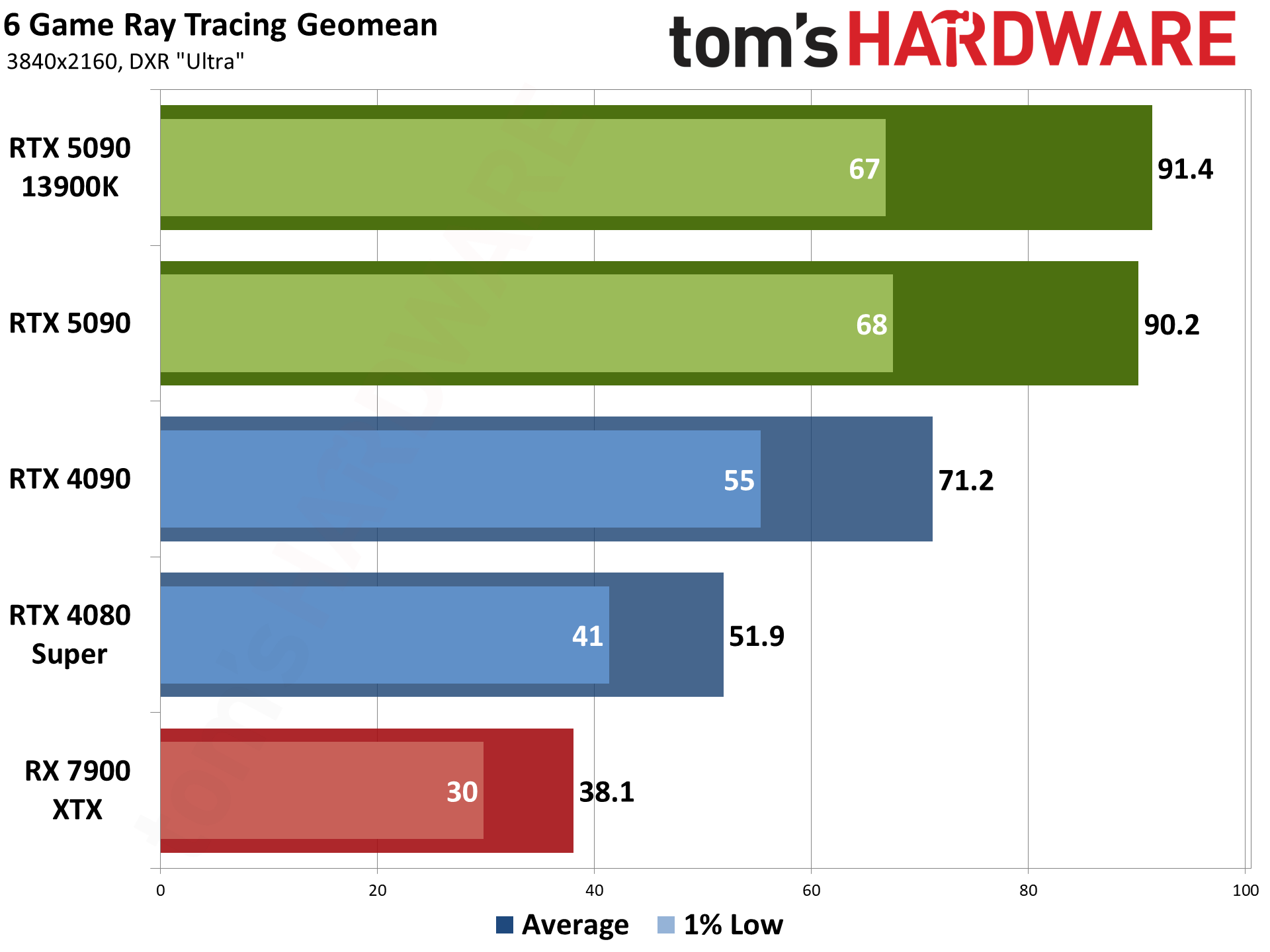
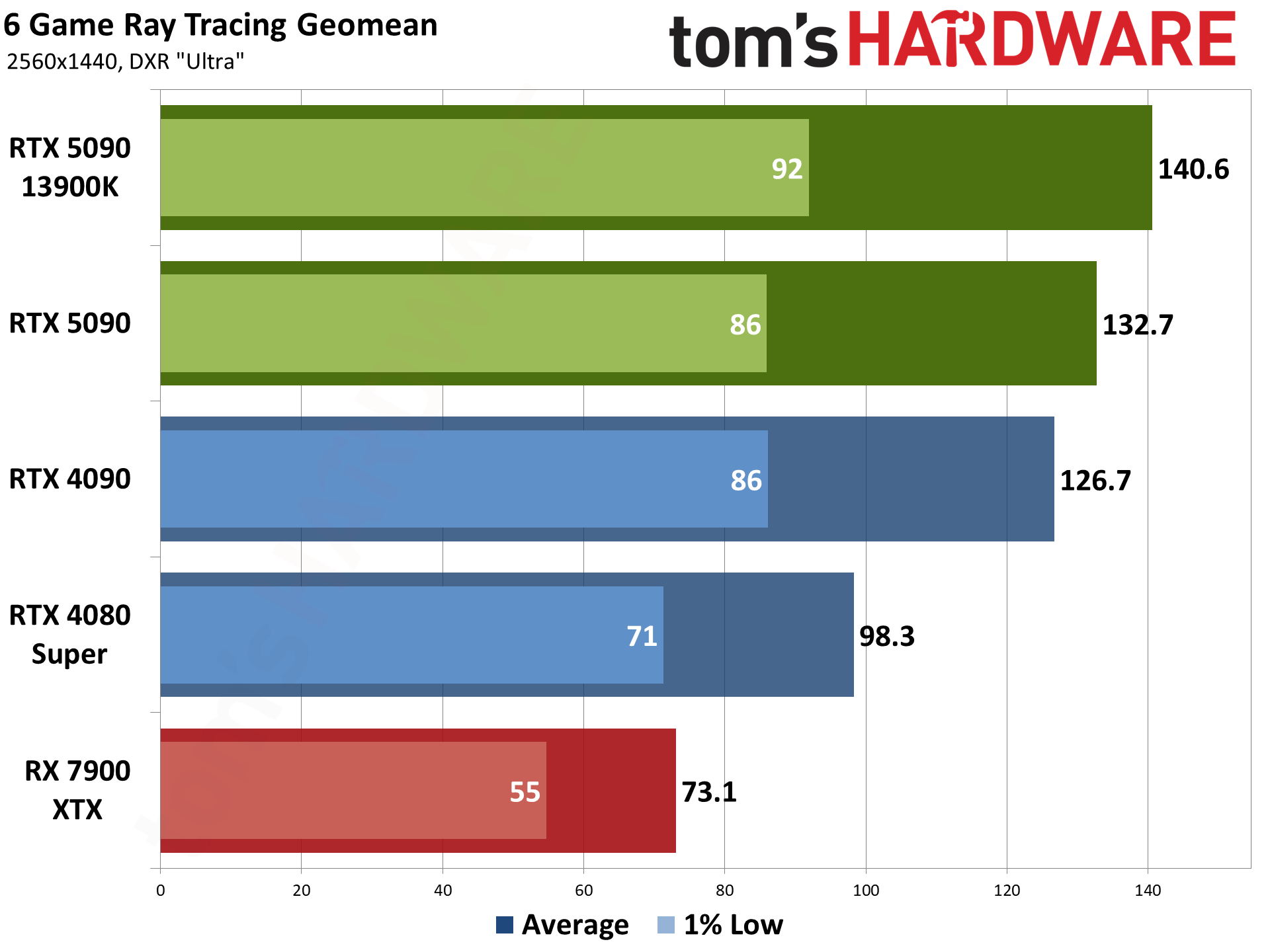
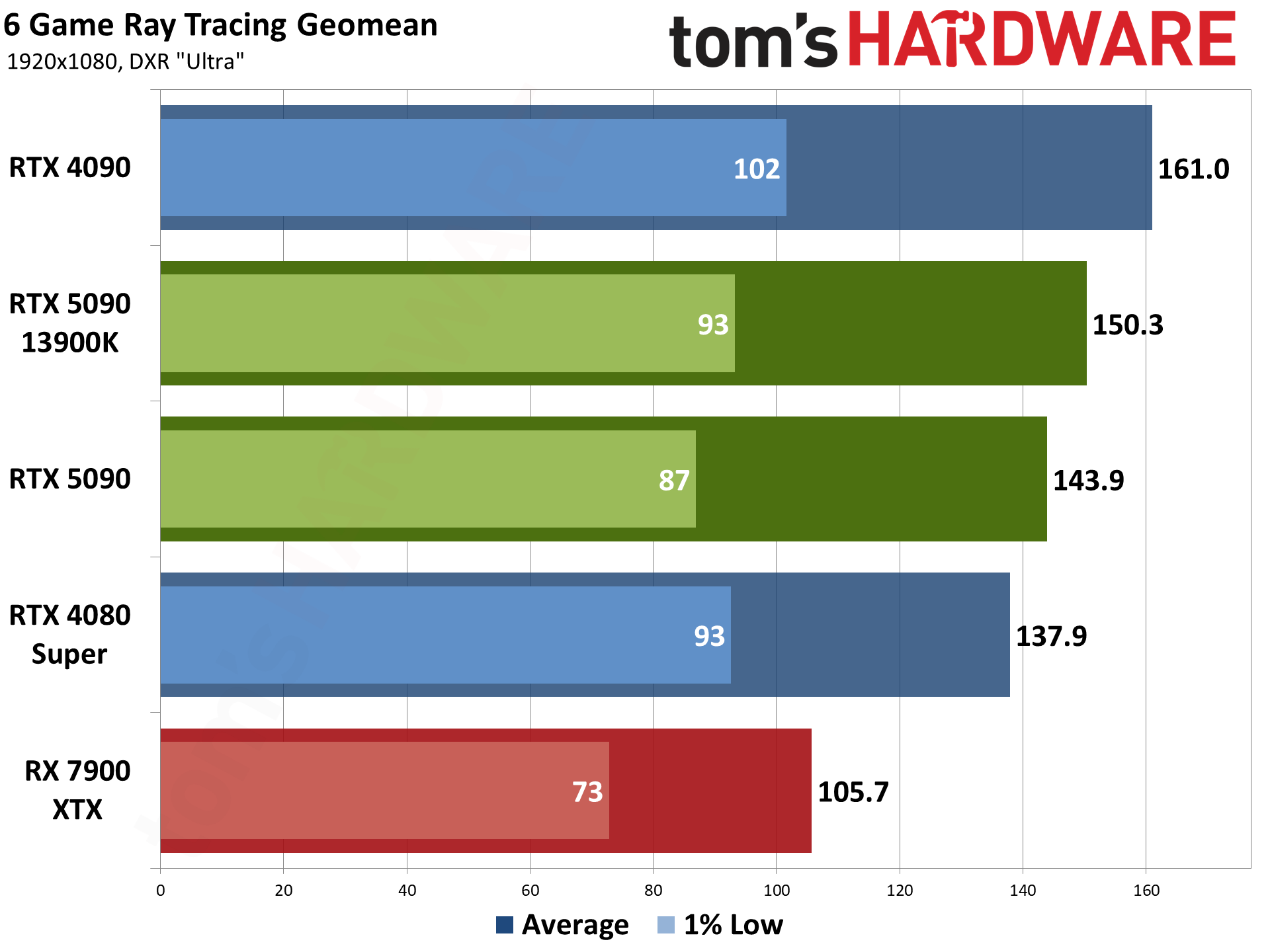
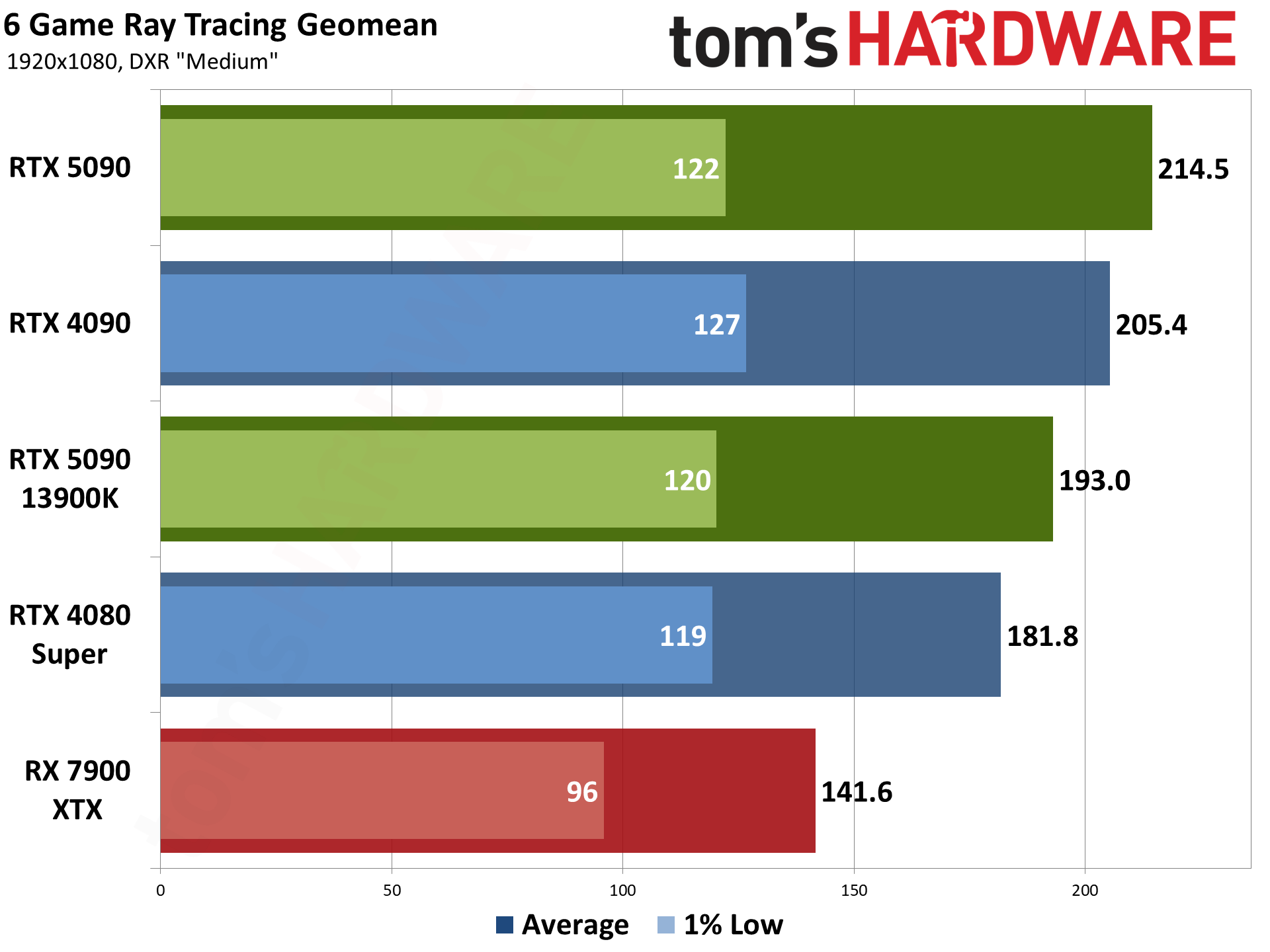
The RTX 5090 can dominate when it comes to ray tracing performance. The RTX 4090 was already far ahead of the competition, at times more than doubling the performance of the closest non-Nvidia GPU. With the RTX 5090, Nvidia delivers up to 42% higher performance than the incumbent... except when things go wrong.
To be clear, we think any performance regressions shown in our charts on the 5090 are the result of having a new architecture, which requires different driver tuning to extract maximum performance. Blackwell isn't just Ada Lovelace with FP4 support, in other words, and the drivers at times feel a bit raw. We expect this will improve in coming days, particularly with games where the 5090 falls far behind the 4090 (i.e. Minecraft on the 9800X3D).
For now, the 5090 with the 13900K CPU actually comes out slightly ahead of the 9800X3D results, even at 4K. But that's mostly due to Minecraft. At 4K, though, the 13900K does end up slightly faster than the 9800X3D in four of the six tests. Drop to 1440p and Minecraft shows a severe 55% deficit on the 9800X3D, and a 64% deficit at 1080p ultra — but then it's sort of fine (not as bad) at 1080p medium.
We'll hit all the individual results in a moment, but first let's get to the big picture.
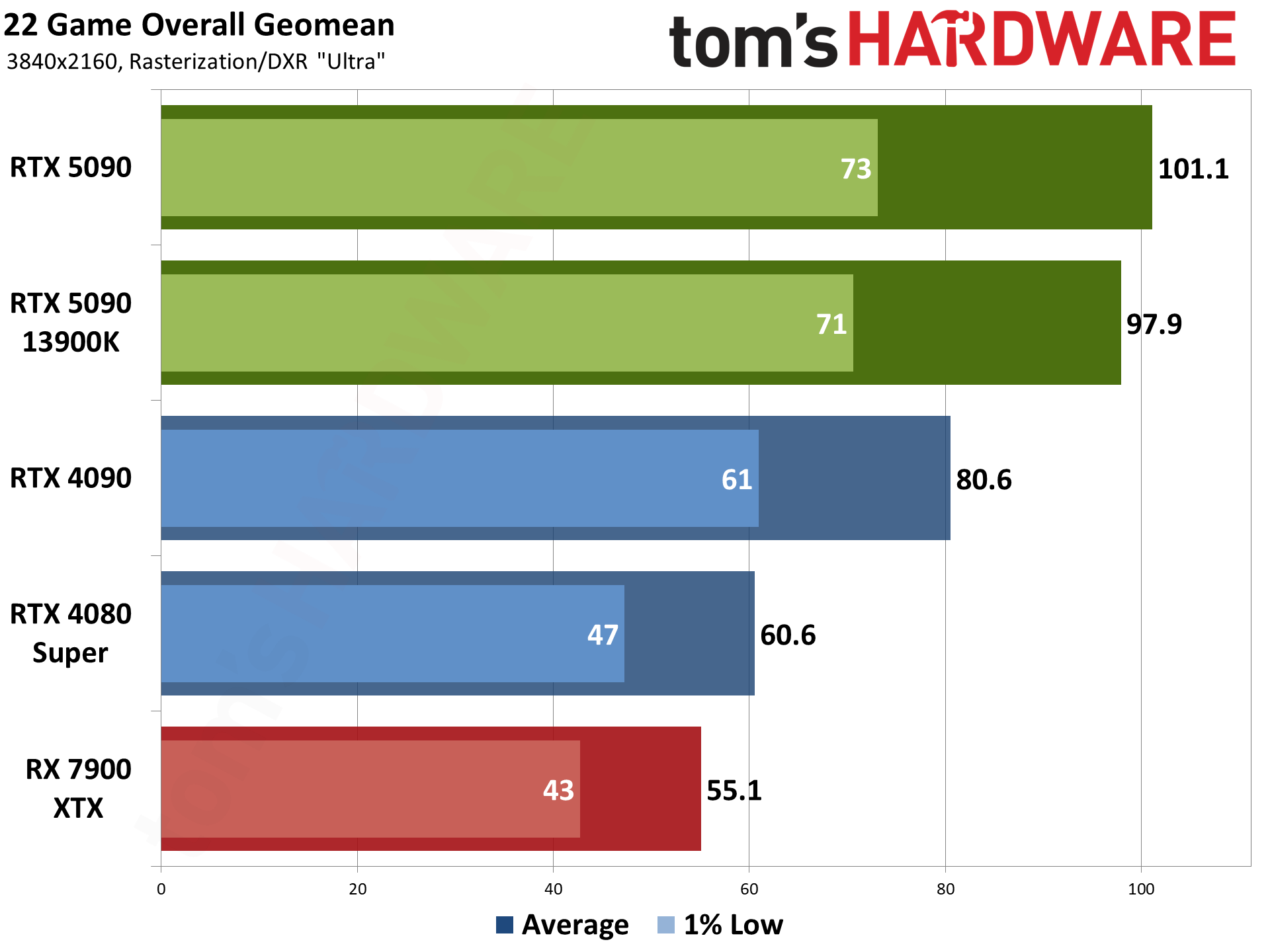
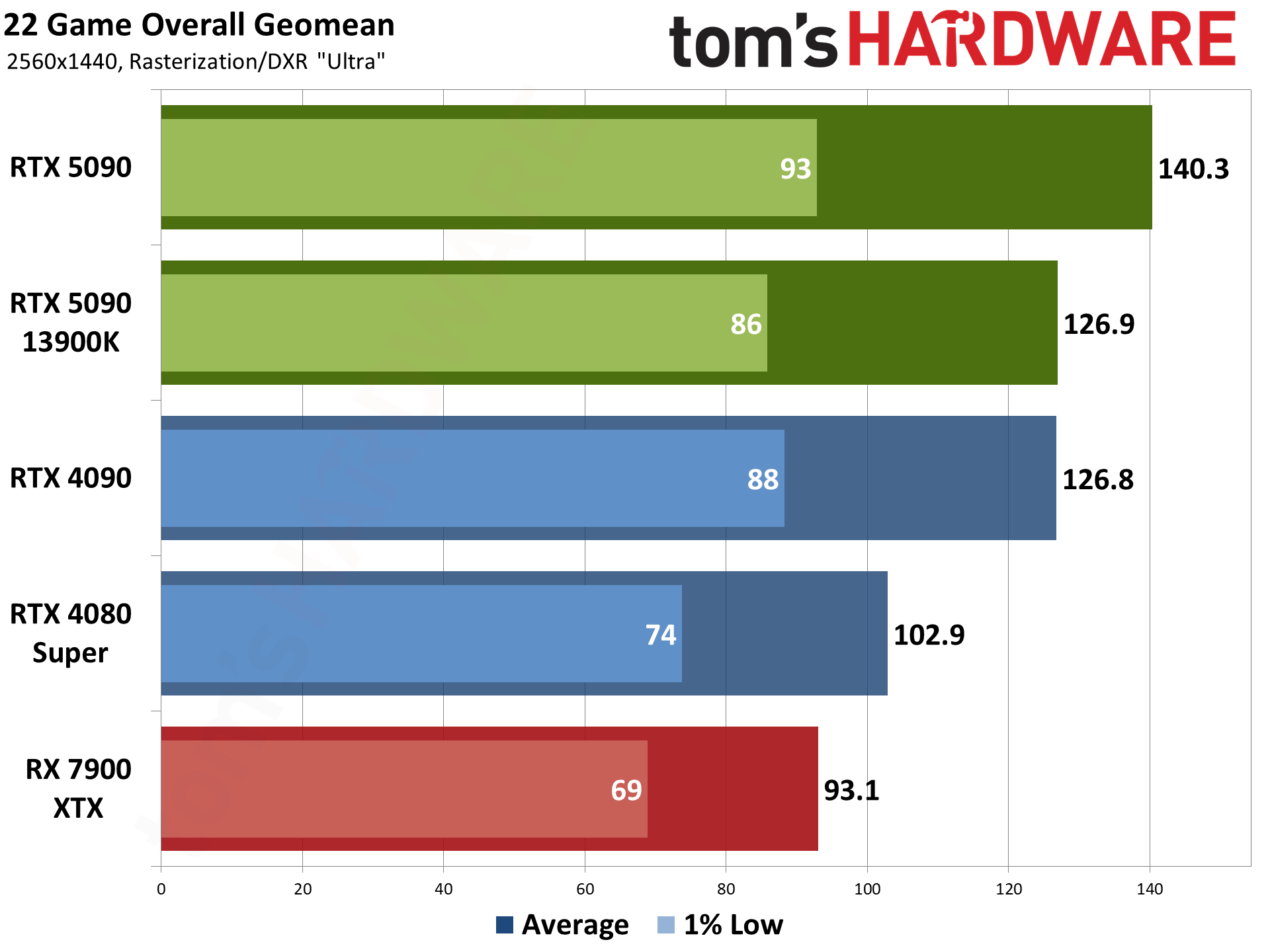
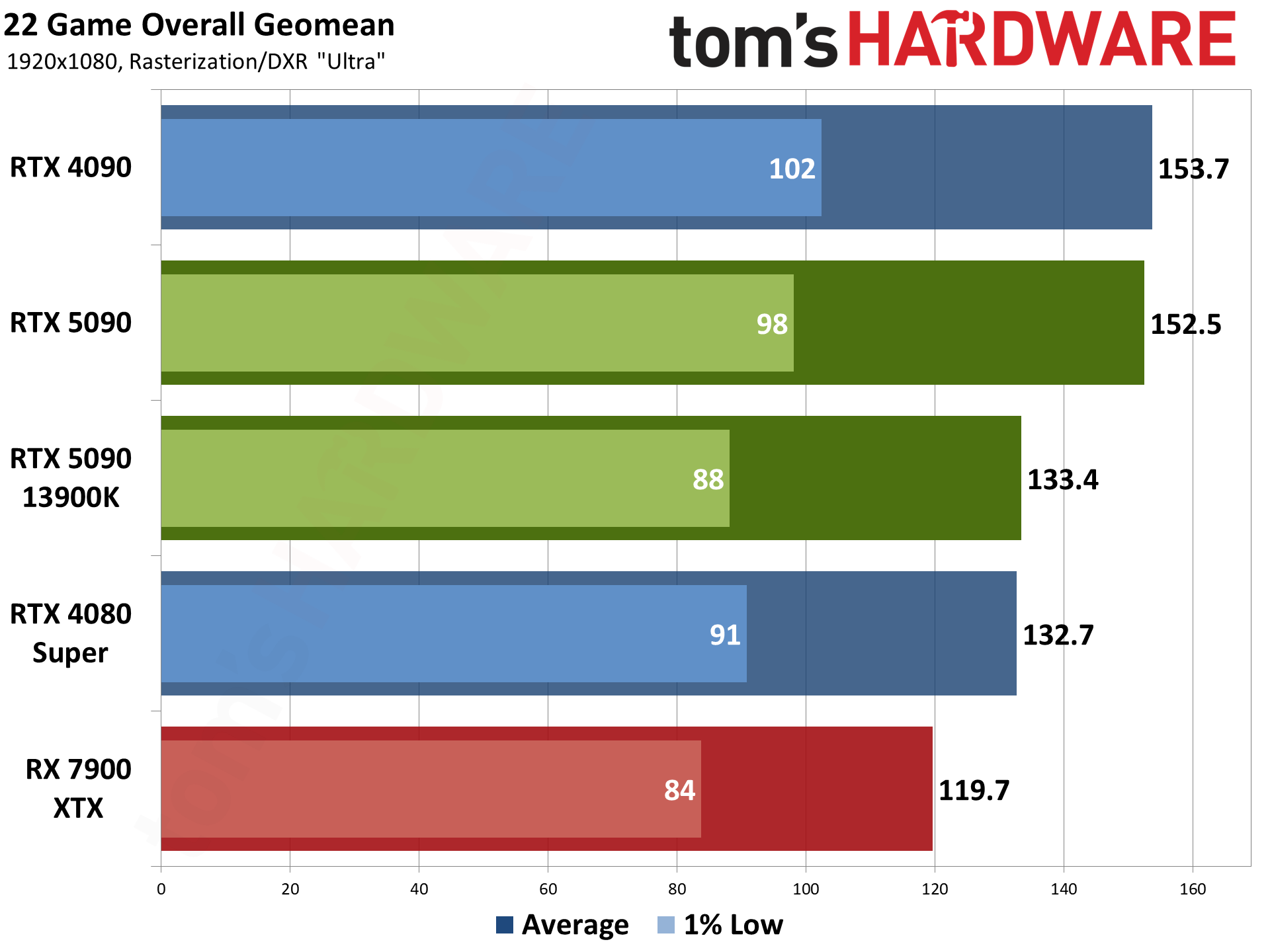
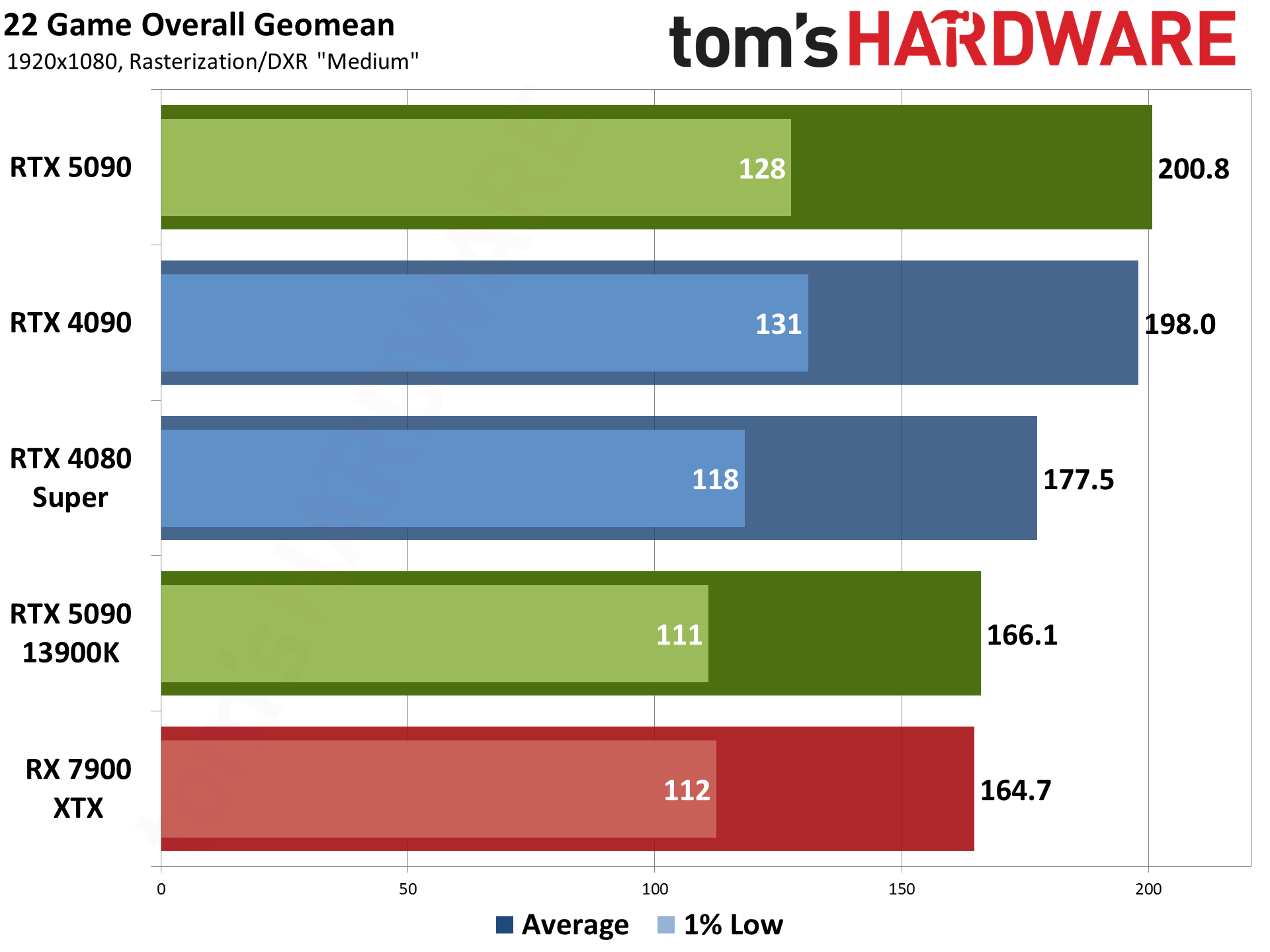
Here's the high level overview that combines the rasterization and ray tracing results. These charts use the geomean of all 22 games that we've tested, with RT accounting for a bit more than a quarter of the overall score.
We think it's fair to say that there are a lot of RT games where the tech doesn't really do much other than tank performance, but there are also a select few games that definitely benefit visually from RT. So, we have far more rasterization games in our suite but still include a handful of RT games to give a more balanced overall view of how the GPUs stack up.
And yes, that even includes full RT (aka path tracing). It's supposed to be more accurate, but the complexity often means developers make other tradeoffs to return a playable result. The 5090 can do really well in full RT games, especially if you want to count MFG, but that's really muddying the waters. More on the next page.
Due to the performance anomalies we've already mentioned a few times, we expect the performance results for the 5090 in particular will change over time. Right now, the 5090 ends up 26% faster than the 4090 across our full test suite, at 4K ultra. That drops to 11% at 1440p, -1% at 1080p ultra, and +1% at 1080p medium. Below are the individual game charts for ray tracing.
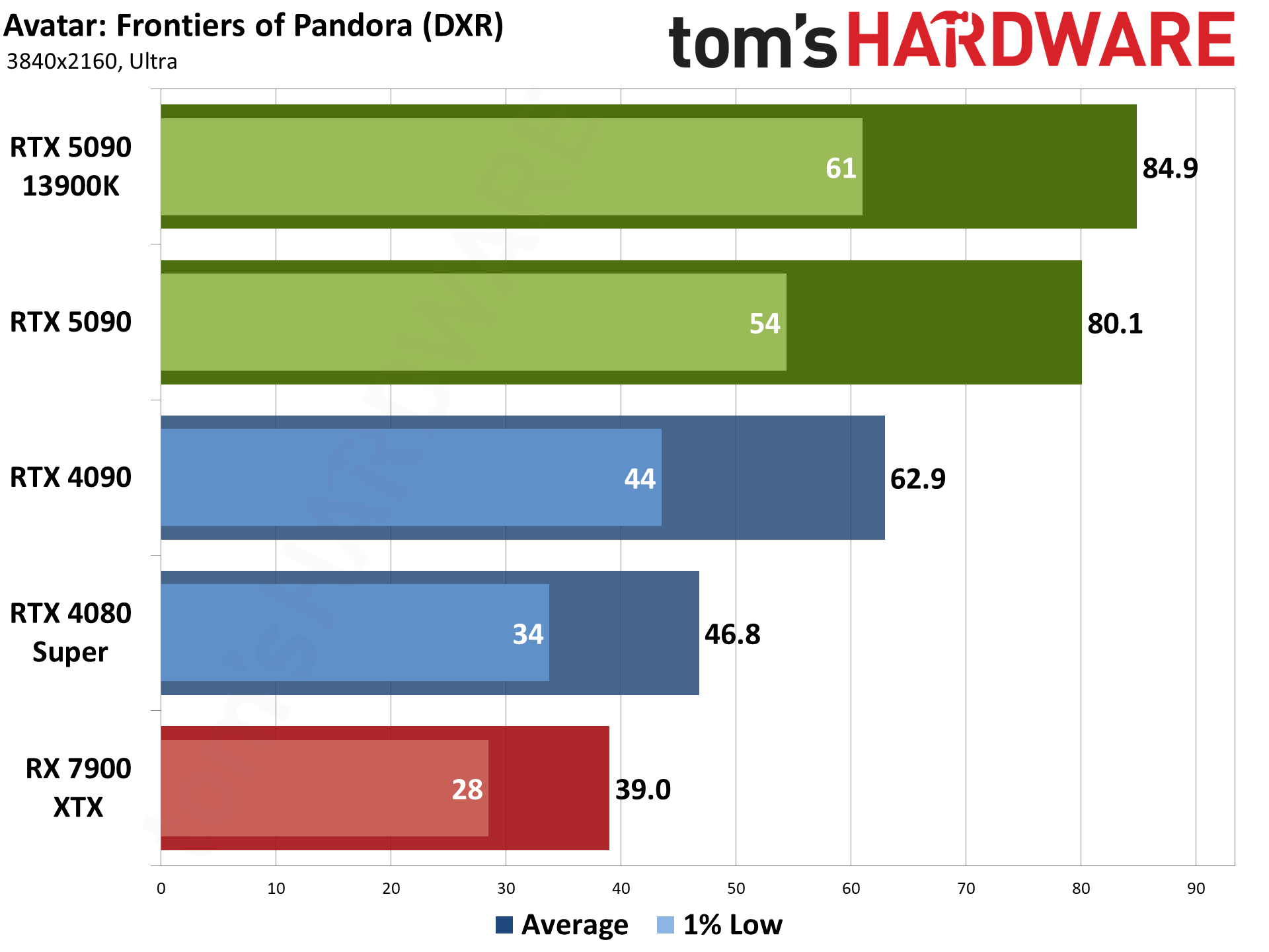
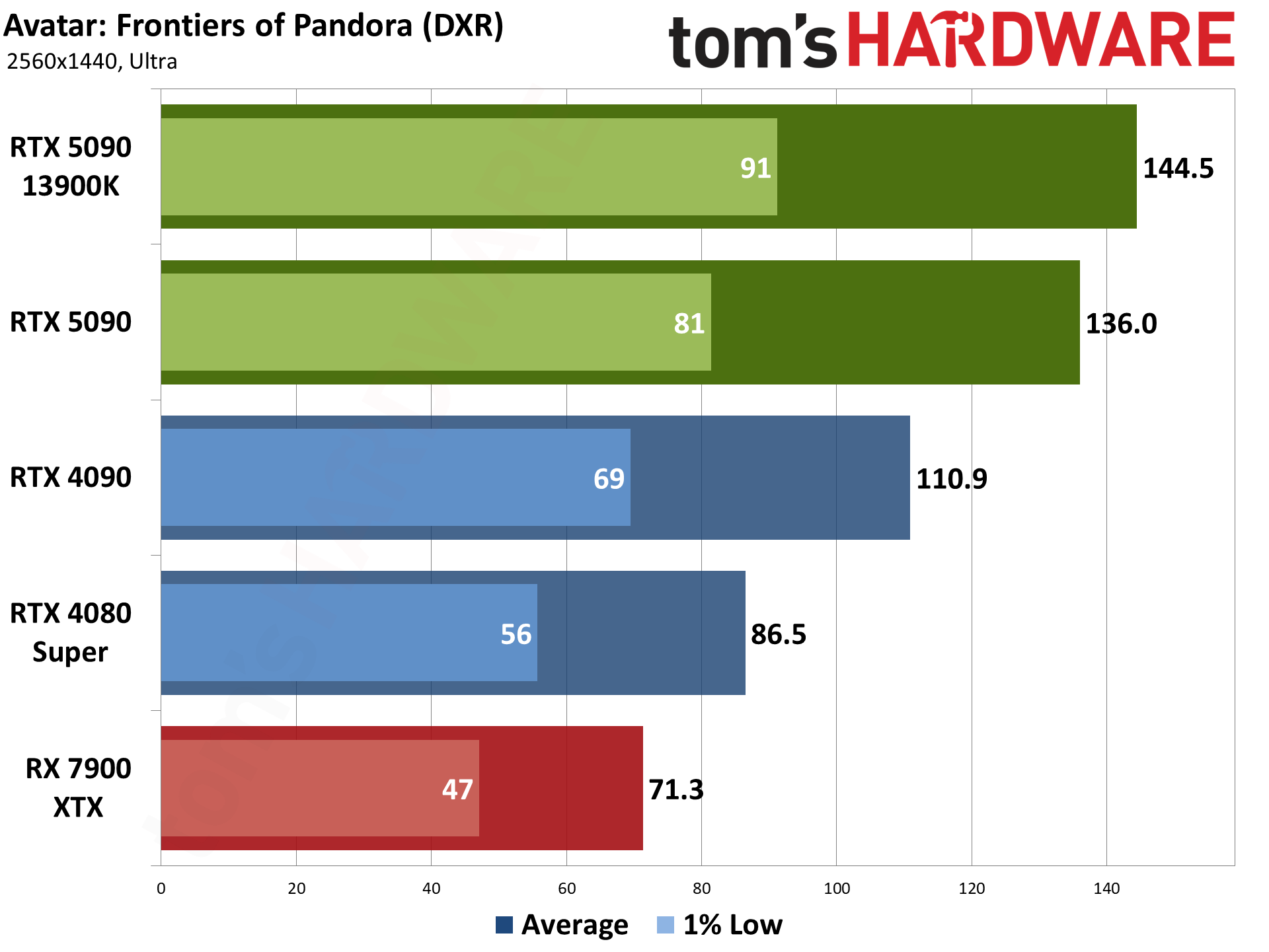
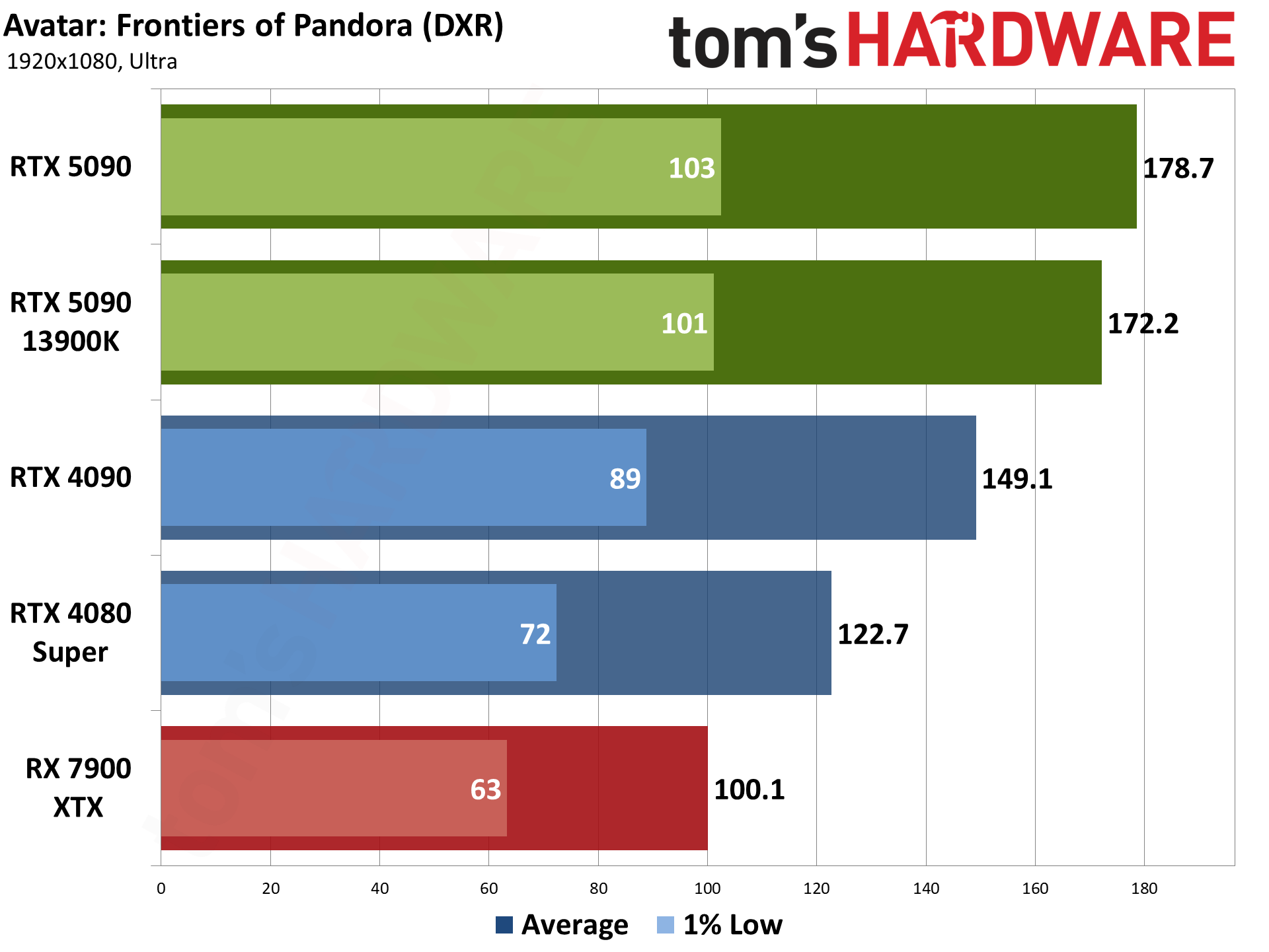
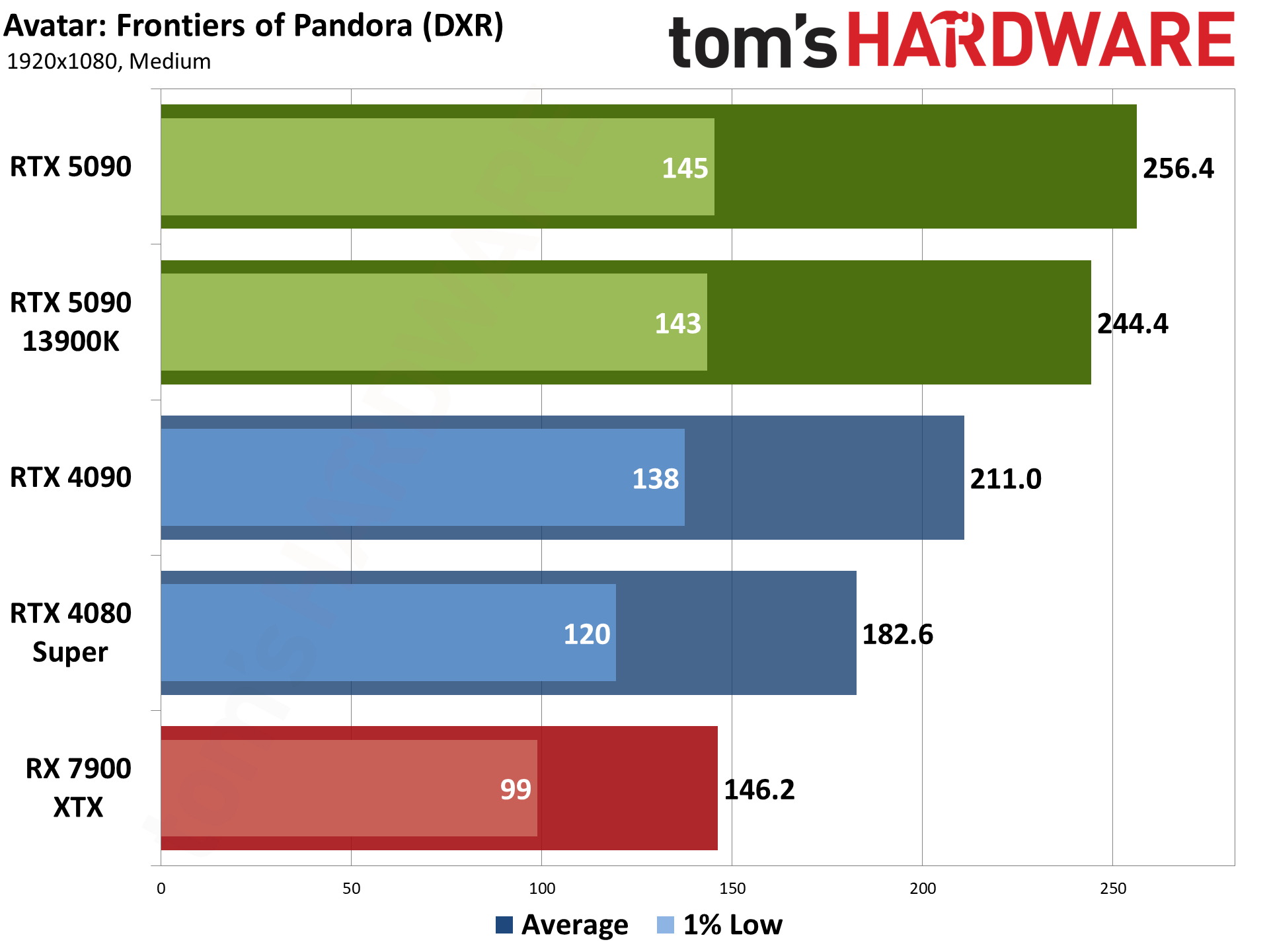
Avatar: Frontiers of Pandora uses ray tracing, but it's not particularly forthcoming on when and where it's used. Reflections in general don't appear to use RT, which is one of the most noticeable upgrades RT can provide. Instead, it's used for shadows and possibly global illumination and some other effects. What I can say for sure is that nothing in the menus (other than "BVH Quality") directly mentions ray tracing, and the performance hit doesn't seem to be as severe as in some games.
Still, since there's RT of some form, this one gets lumped into our DXR suite. Note also how the AMD 7900 XTX lags behind the 4080 Super across all tested resolutions and settings — a key giveaway that this (AMD promoted) game uses ray tracing.
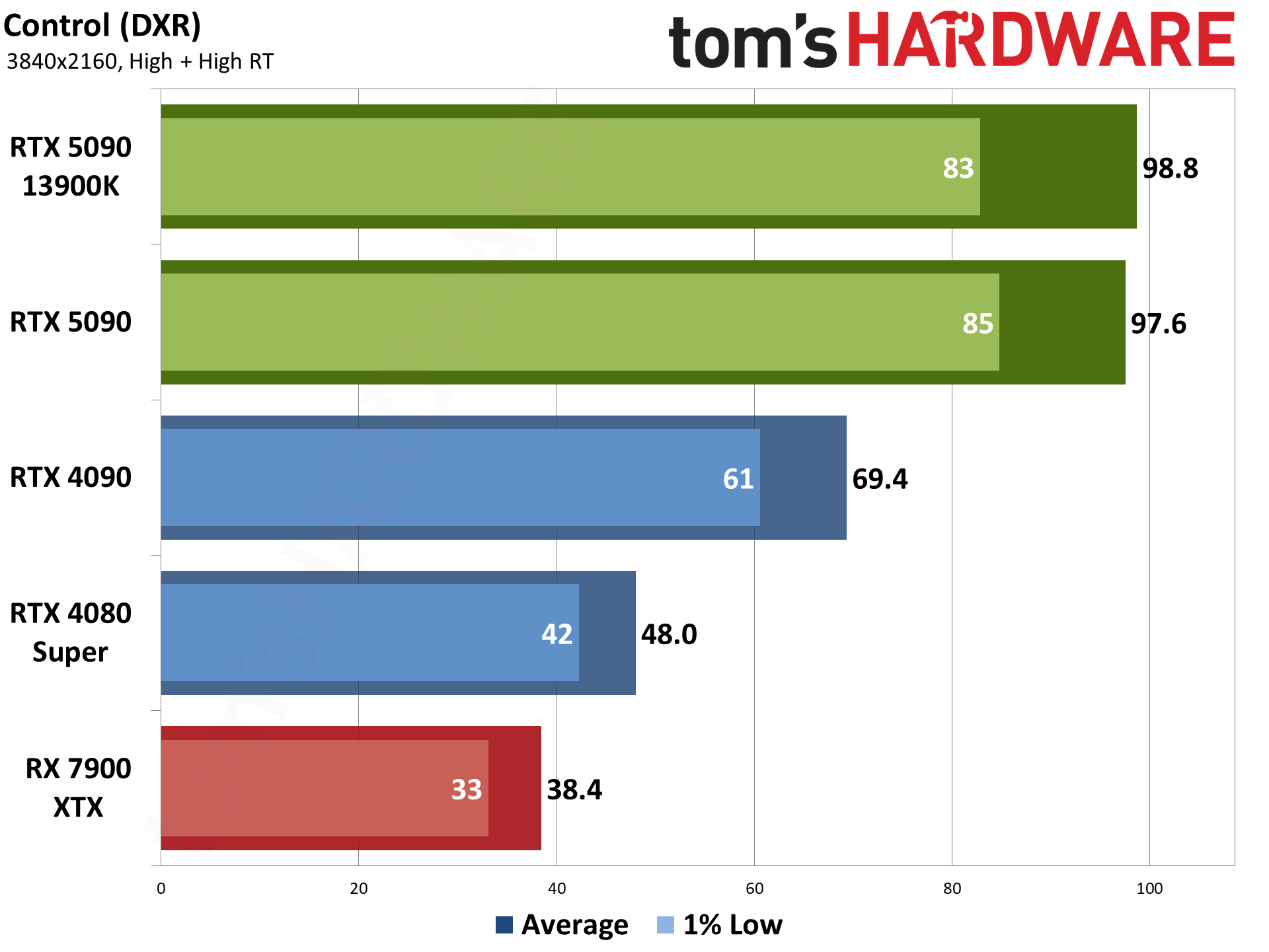
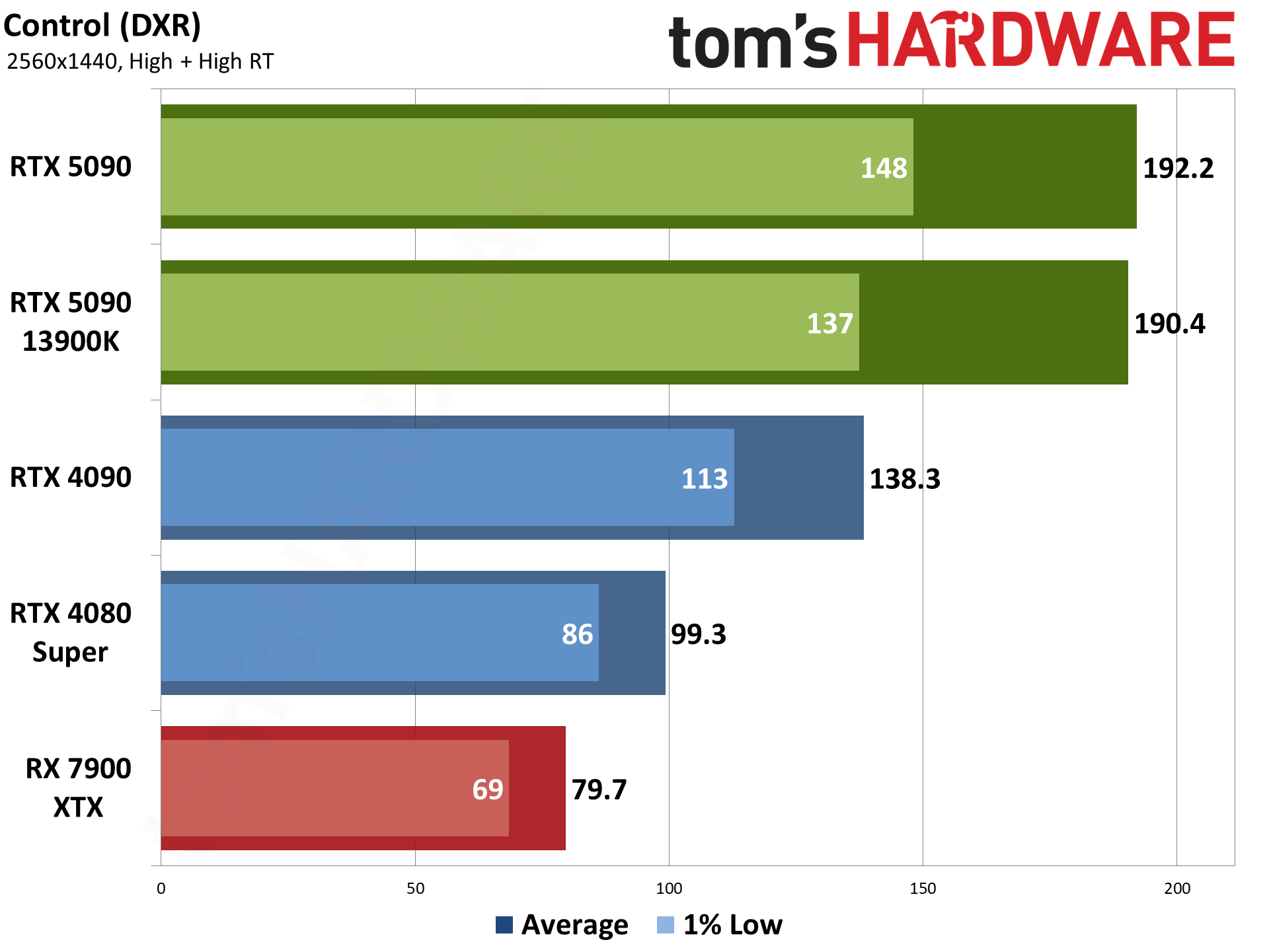
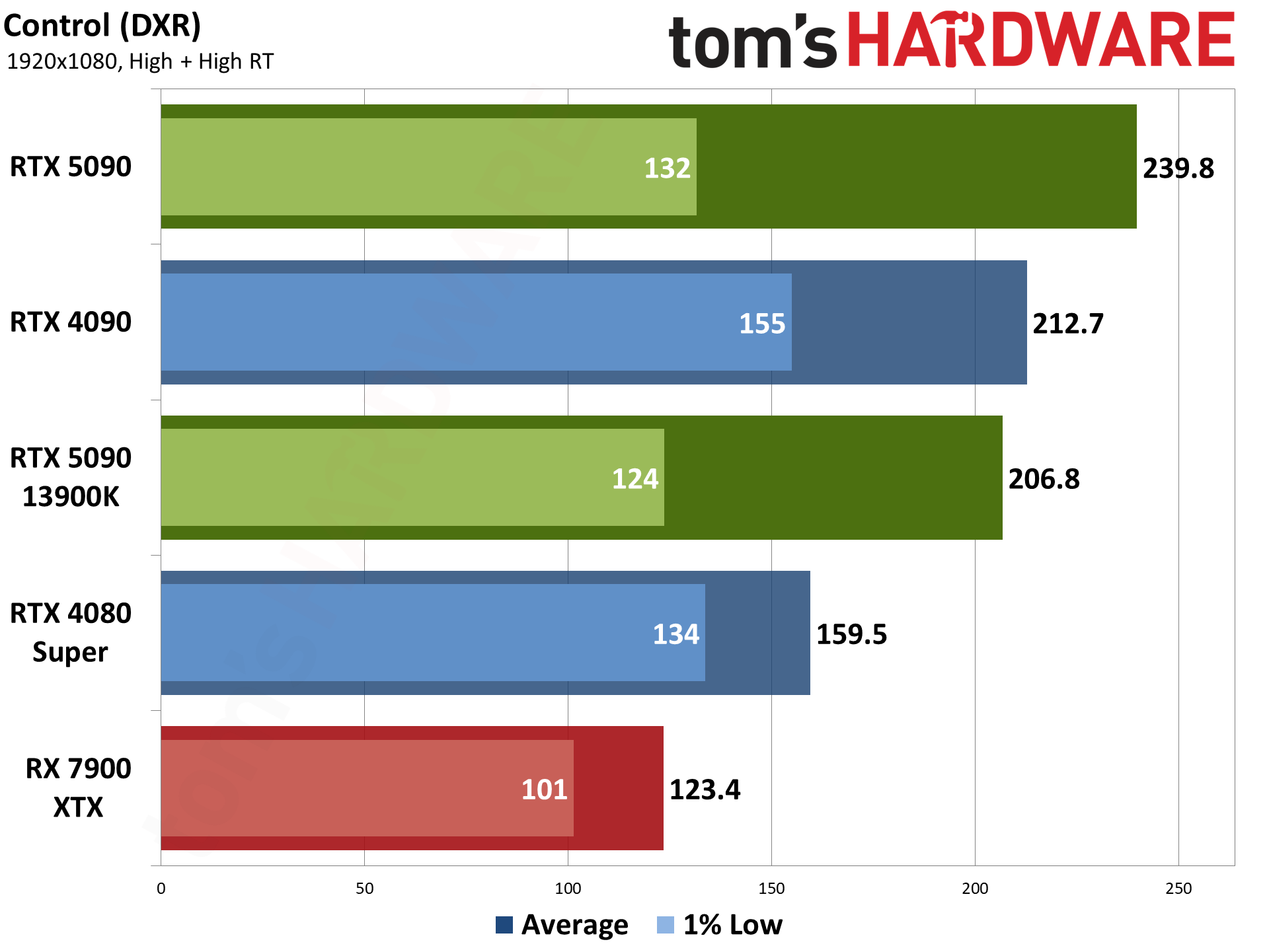
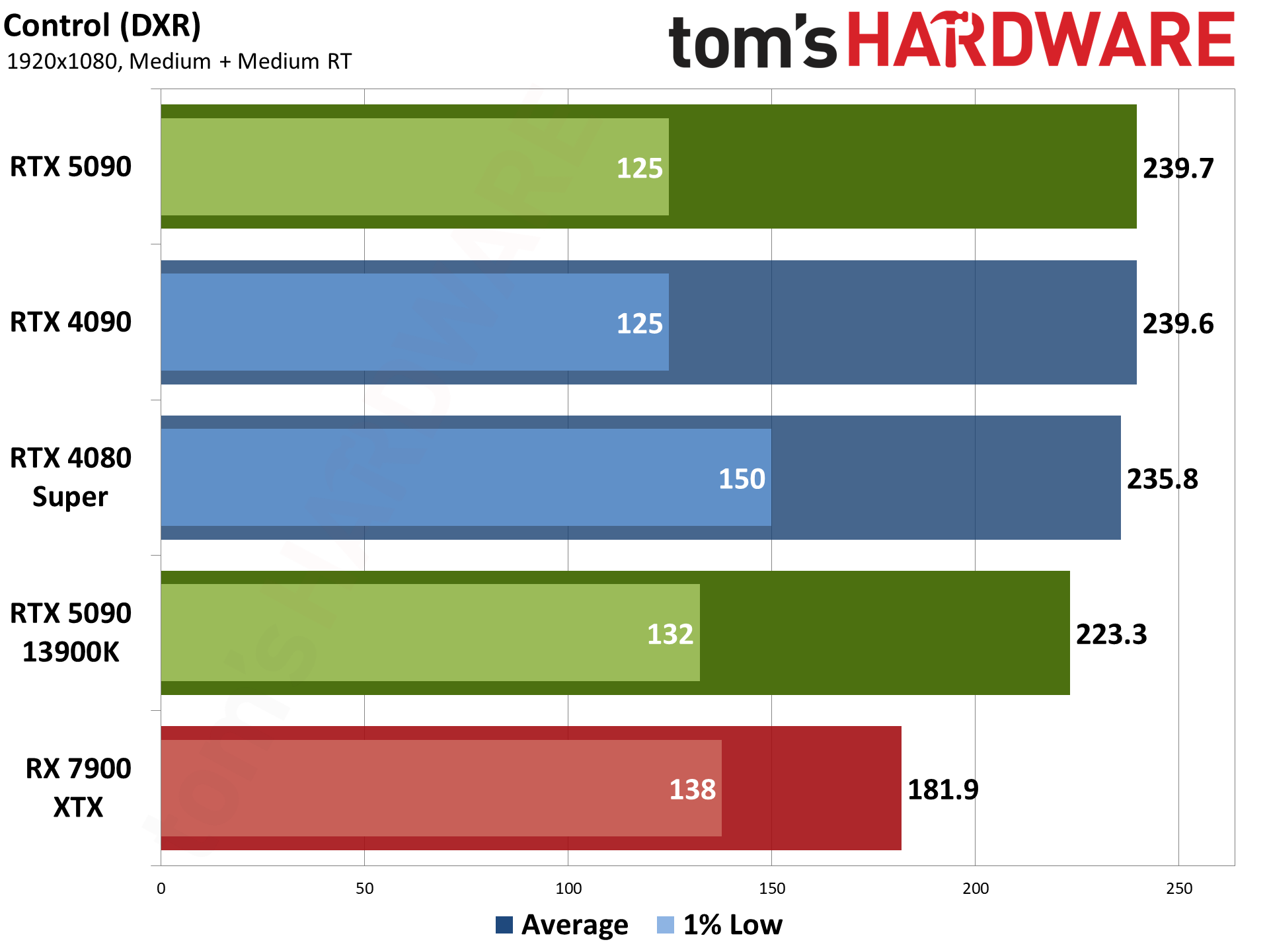
If you want a game where ray tracing is both clearly visible and actually makes the game look better, without totally destroying performance, look no further than Control. It's now five years old, and we're using the Ultimate version, but it's still arguably the best example of using RT well. And probably a lot of that is because you're running around the Federal Bureau of Control, an office space of sorts that has good reasons to have plenty of glass windows that reflect the scenery.
The RTX 5090 has some rendering errors in Control right now, so these results could change quite a bit with updated drivers. There's also a hard 240 FPS cap, and the closer a GPU gets to that mark (or could exceed it), the worse the 1% lows become. That's why the 5090 looks somewhat bad at 1080p. The 13900K also struggles more at 1080p compared to the 9800X3D
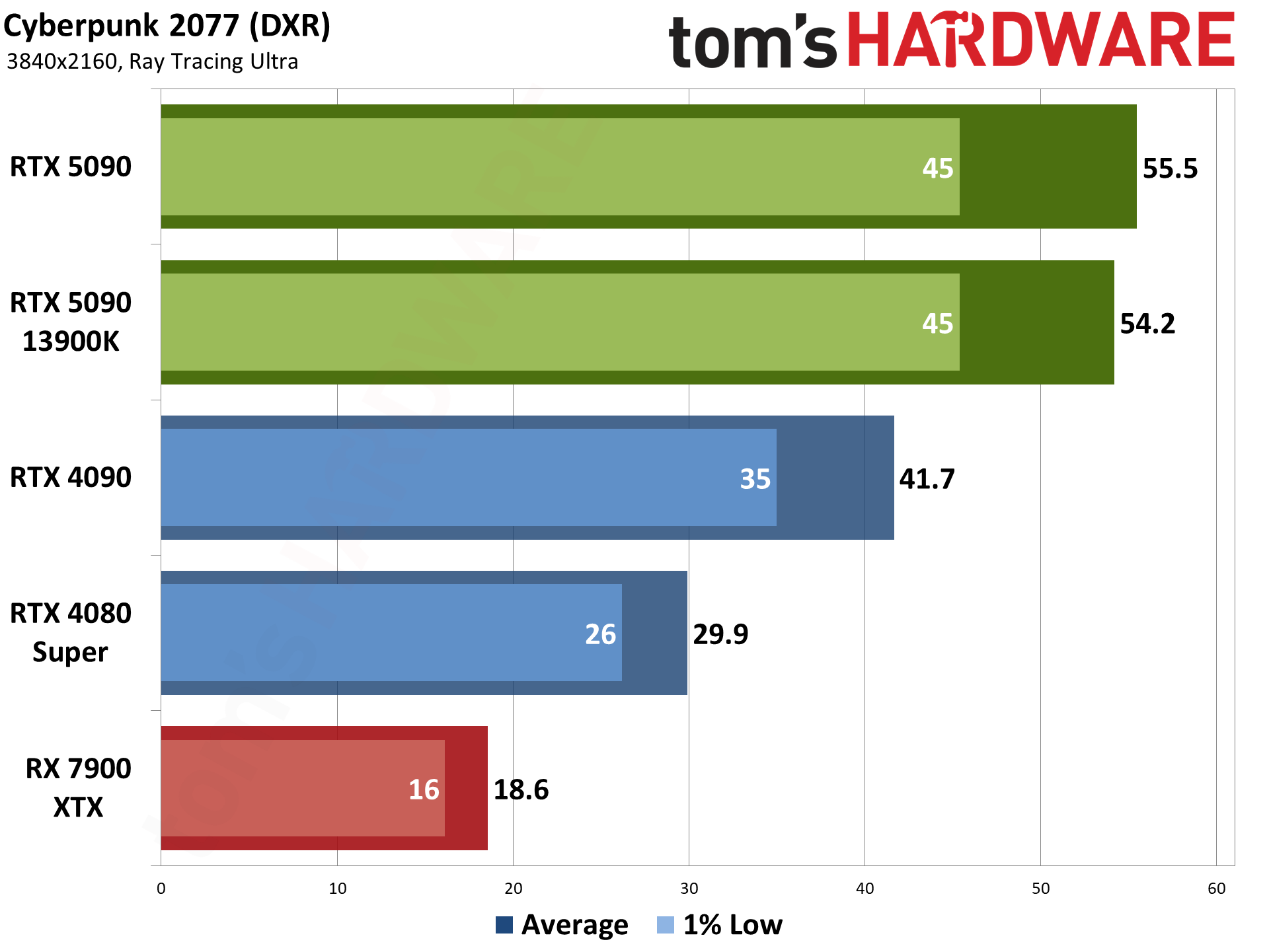
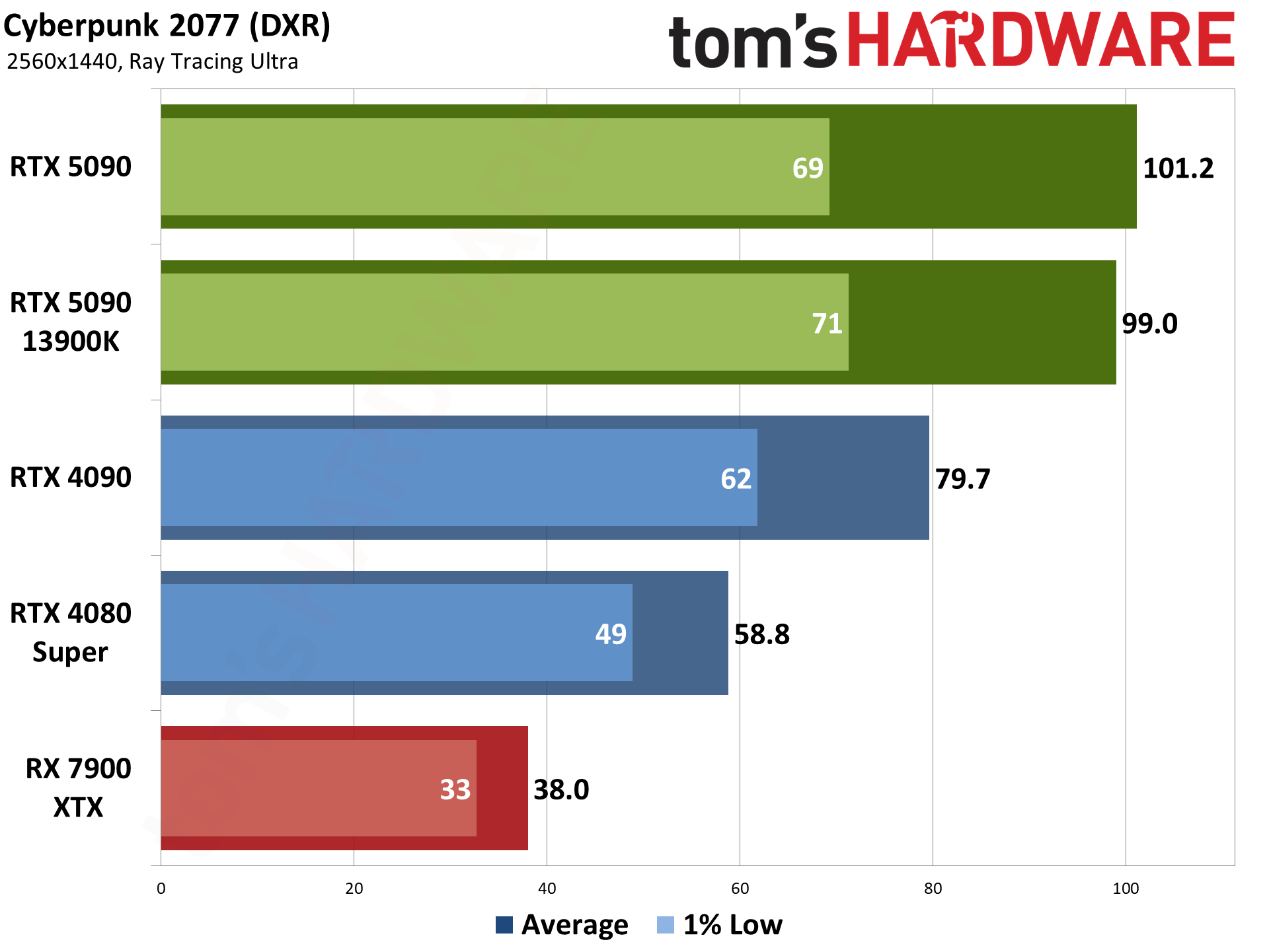
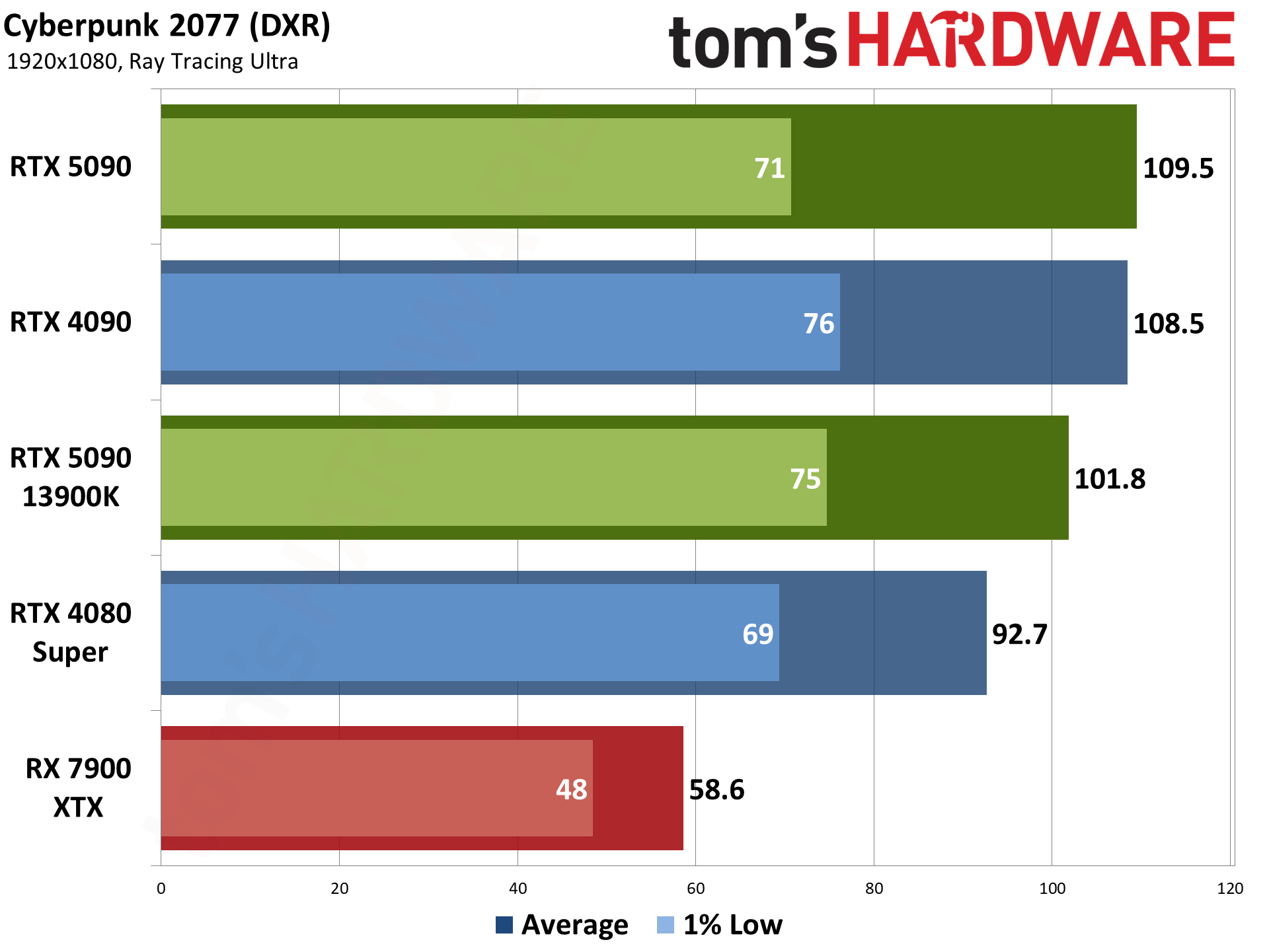
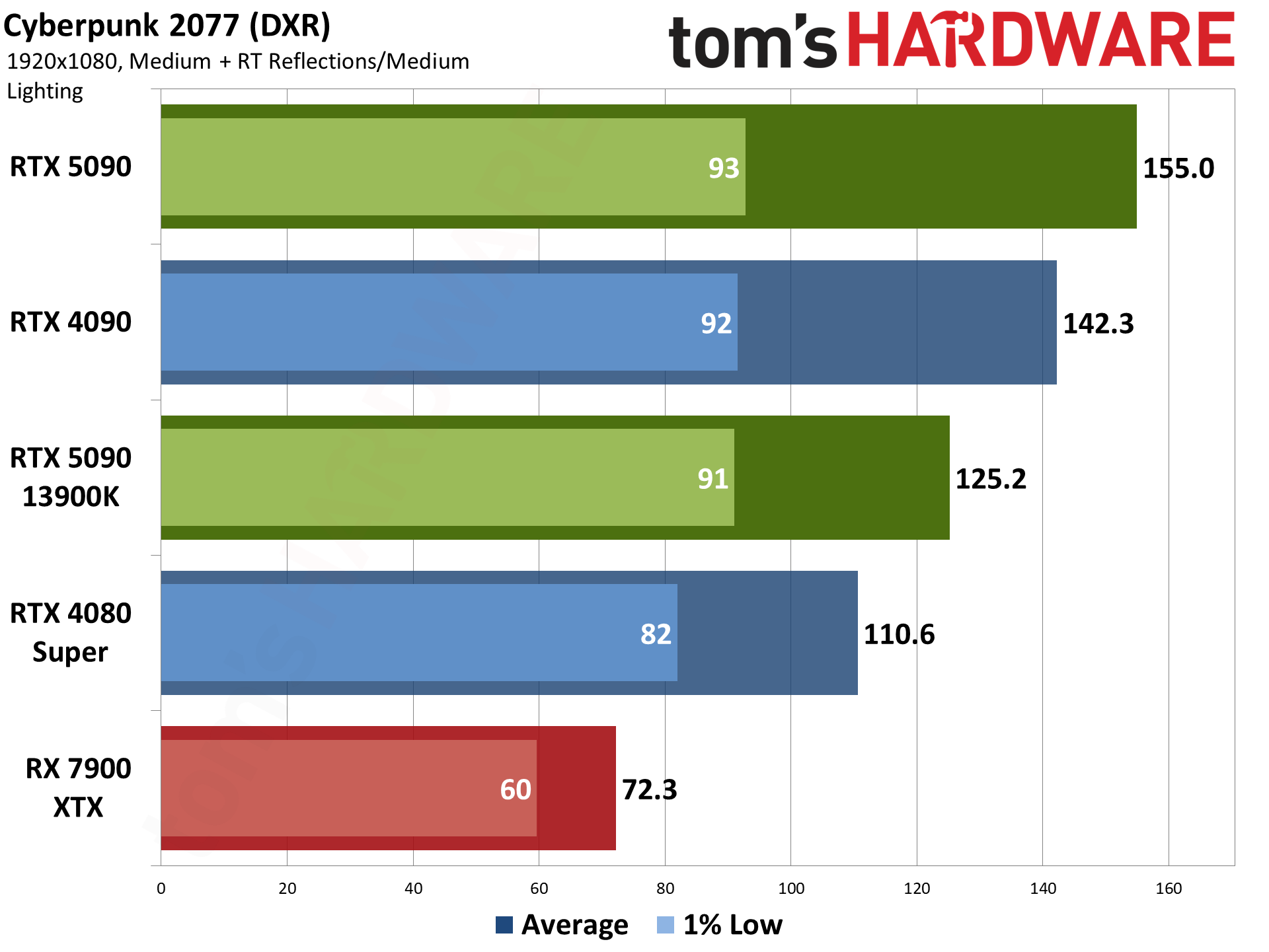
Possibly the most hyped up use of RT in a game, Cyberpunk 2077 launched with more RT effects than other games of its era, and later the 2.0 version added full path tracing and DLSS 3.5 ray reconstruction. Ray reconstruction ends up looking the best but only works on Nvidia GPUs, so as with upscaling it can be a case of trying to compare apples and oranges.
We're using medium settings with RT lighting at medium and RT reflections enabled, and then the step up uses the RT-Ultra preset. In all cases, any form of upscaling or frame generation gets turned off. We'll have more details on Cyberpunk 2077 with RT-Overdrive on the next page, however.
Not surprisingly, this is another big gen on gen win for the RTX 5090, with 33% higher performance than the 4090 at 4K. It's also 27% faster at 1440p, but then tied at 1080p and 9% faster at 1080p with our medium settings.
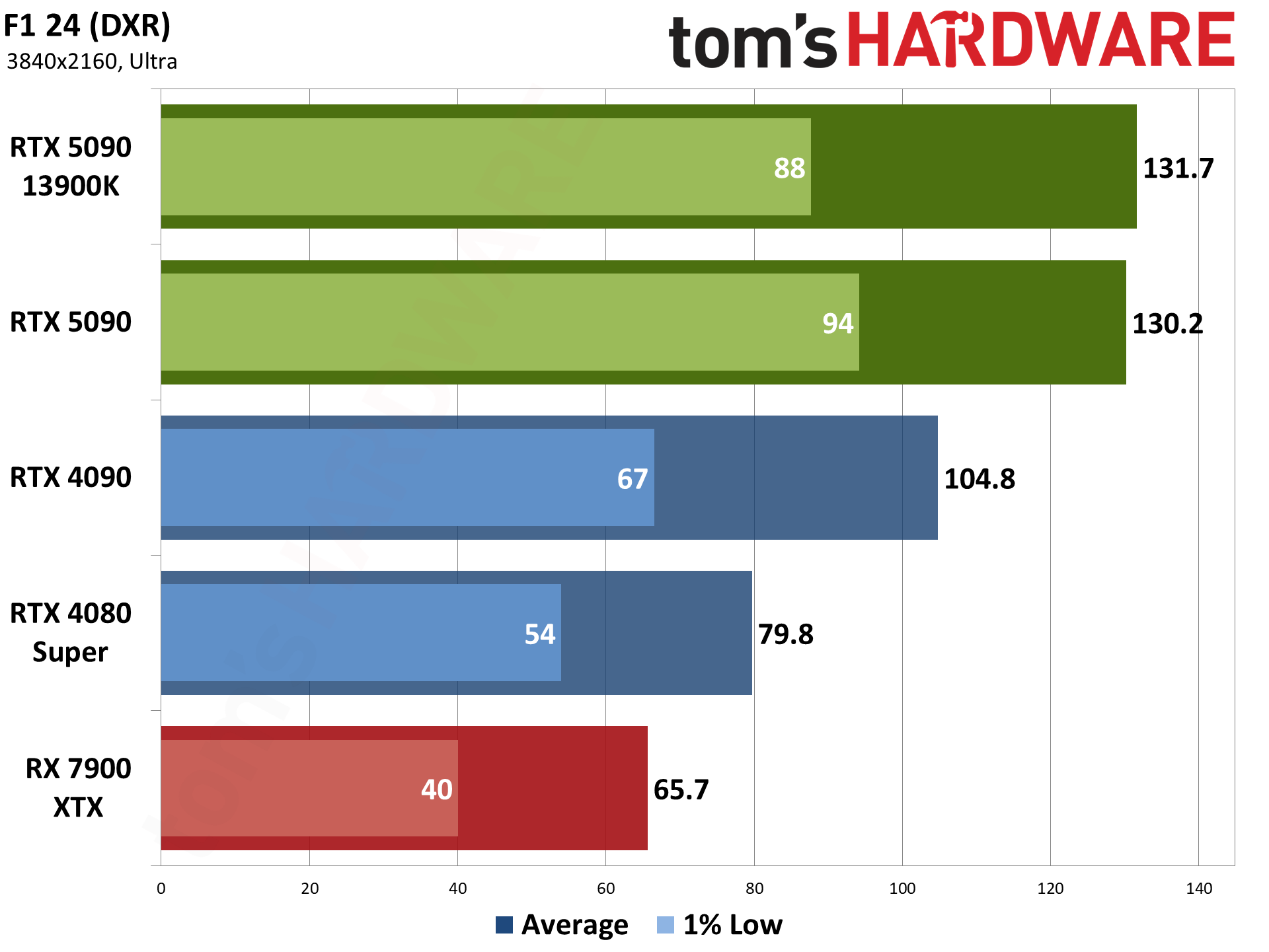
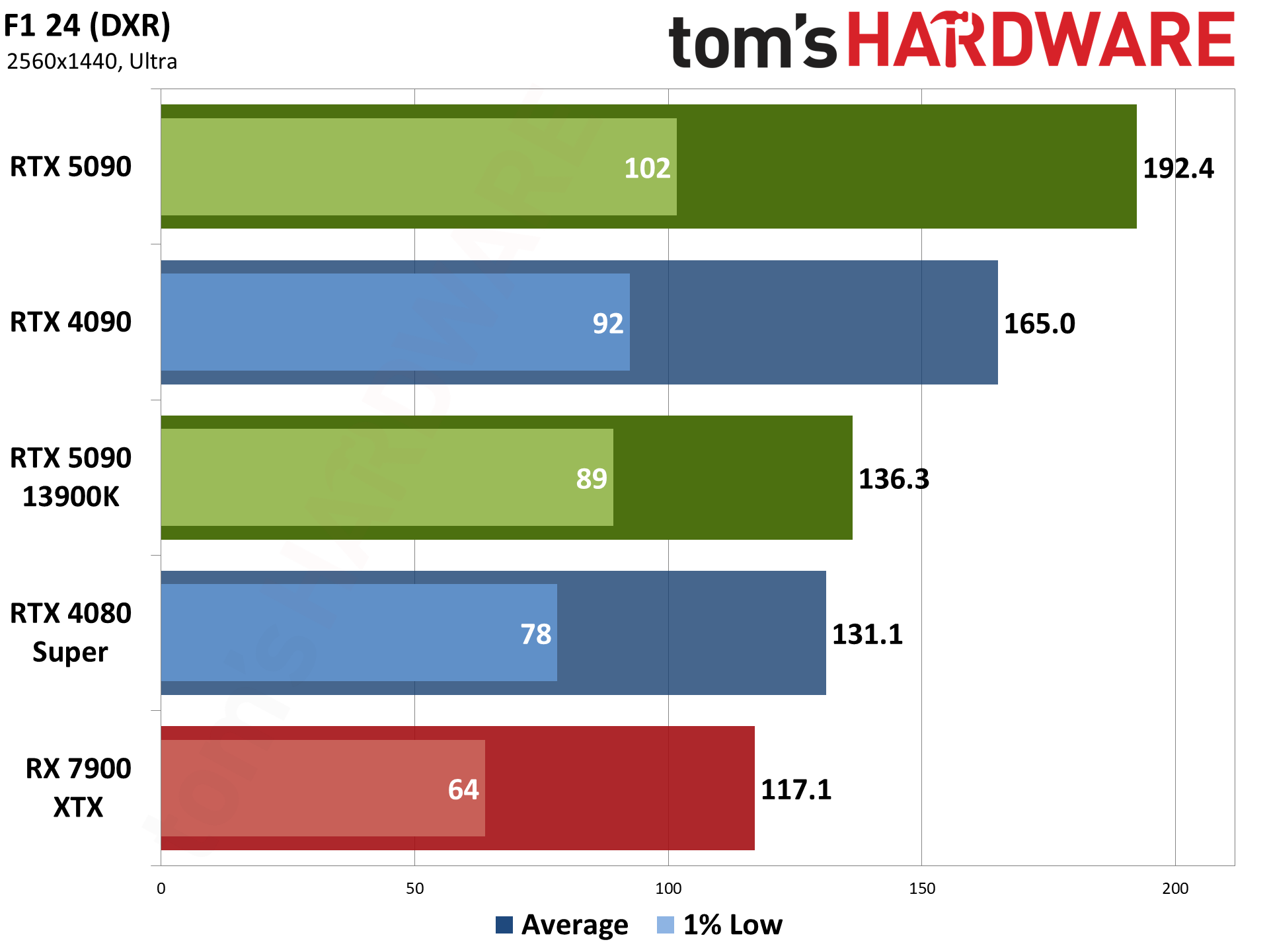
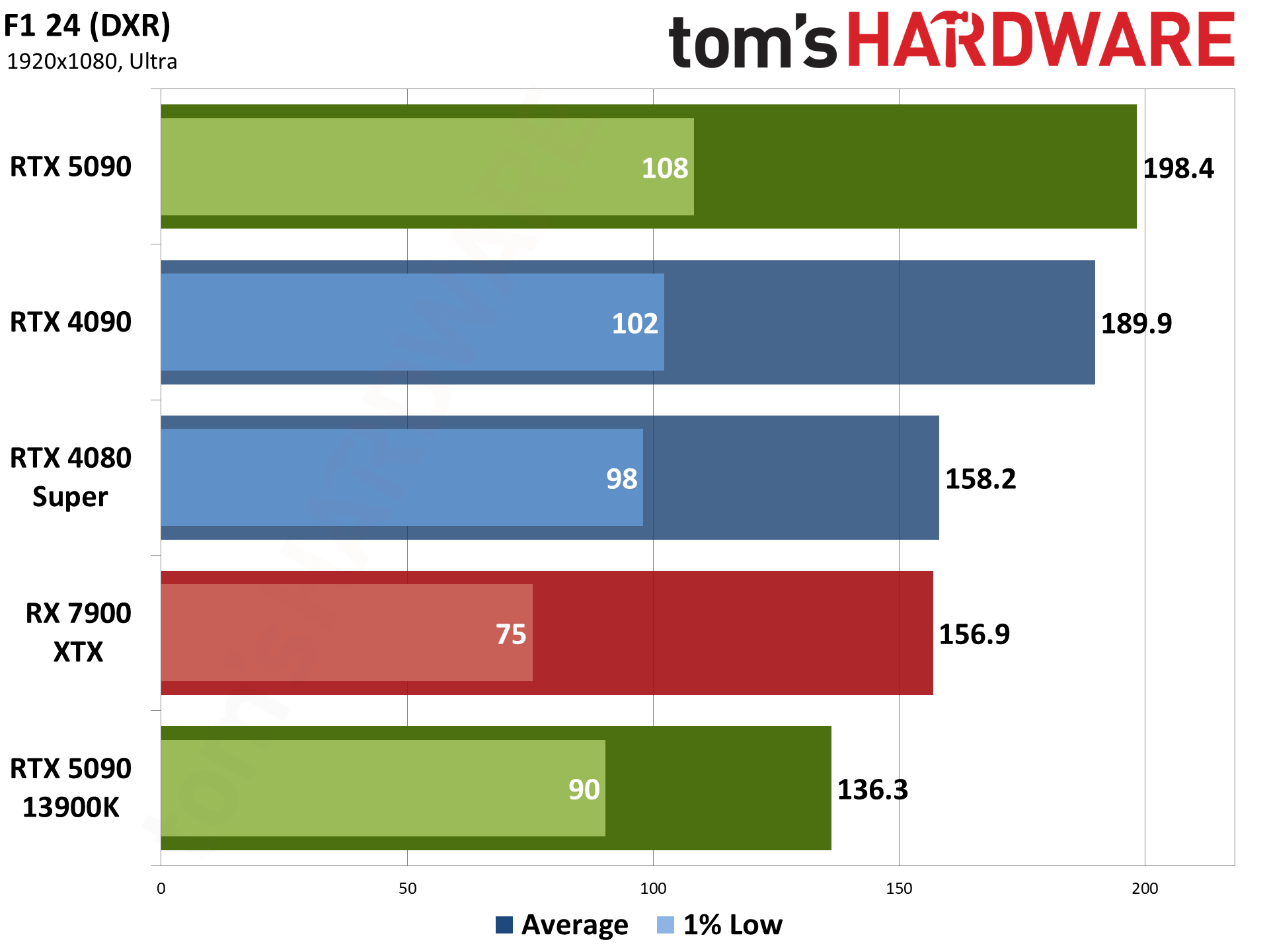
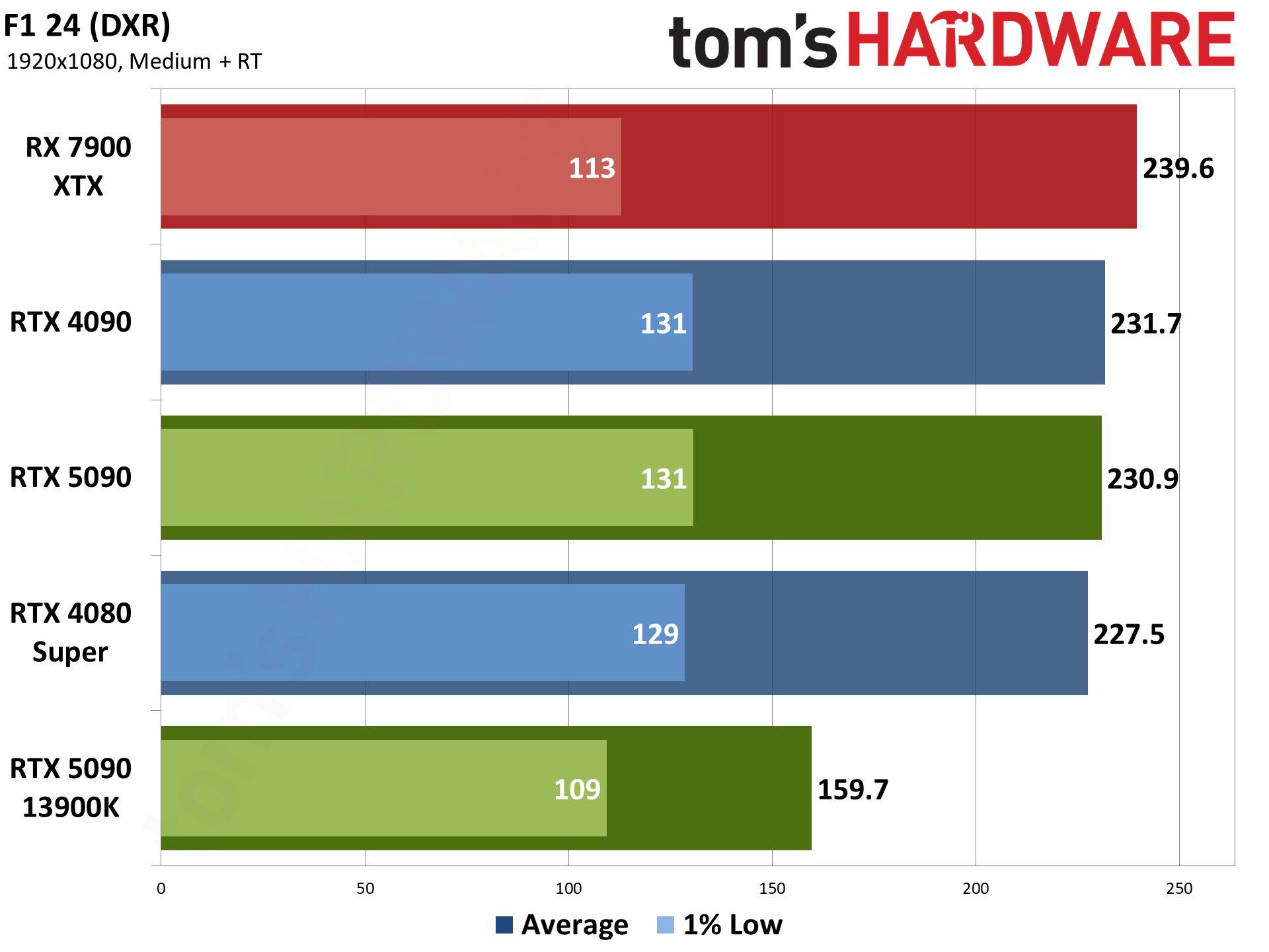
F1 24 enables several RT effects on the ultra preset but leaves them off on medium. But then 1080p medium runs at hundreds of frames per second, so we went ahead and turned all the RT effects on for our testing. We use the Great Britain track for testing, in the rain naturally.
Get Tom's Hardware's best news and in-depth reviews, straight to your inbox.
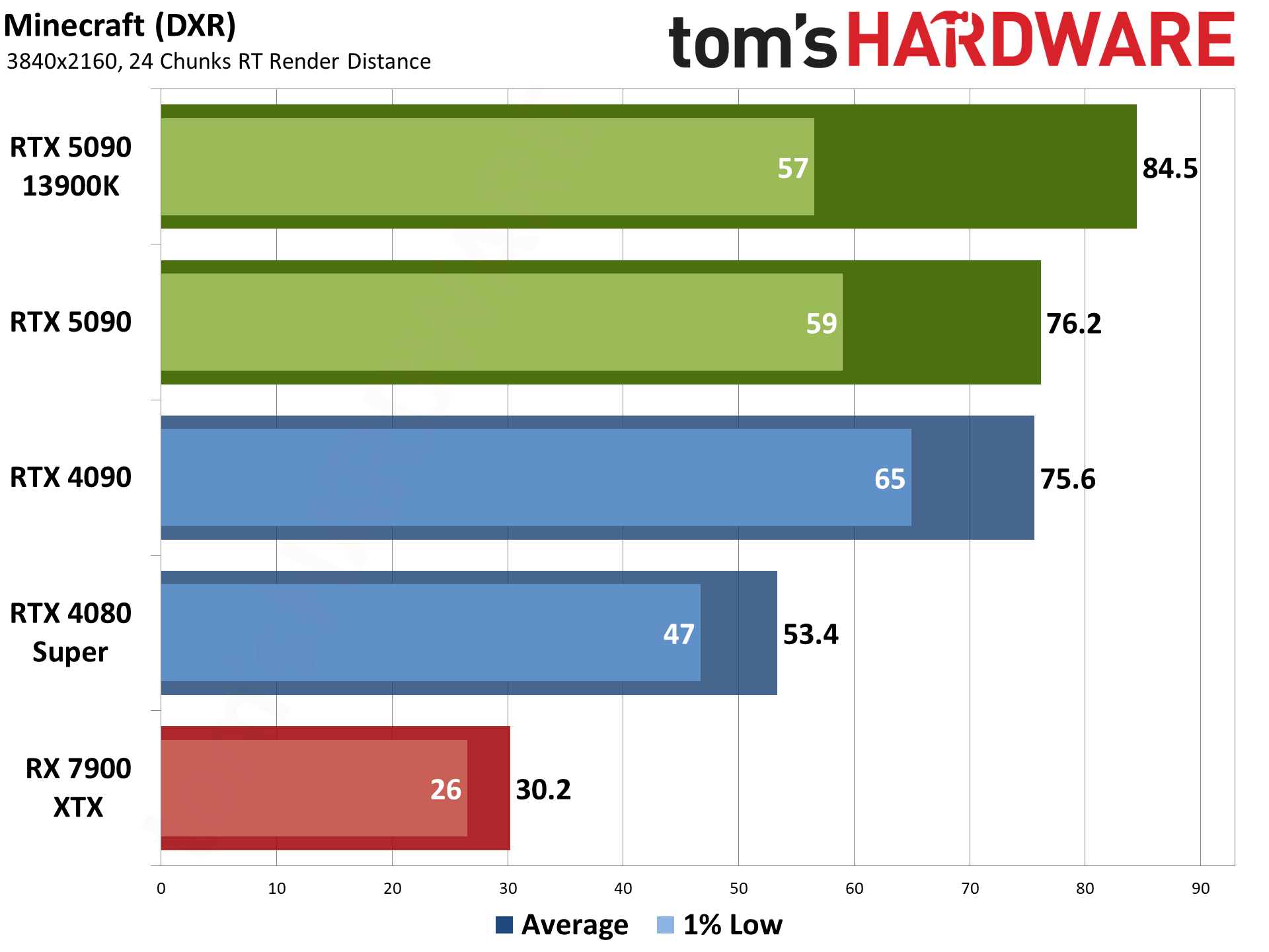
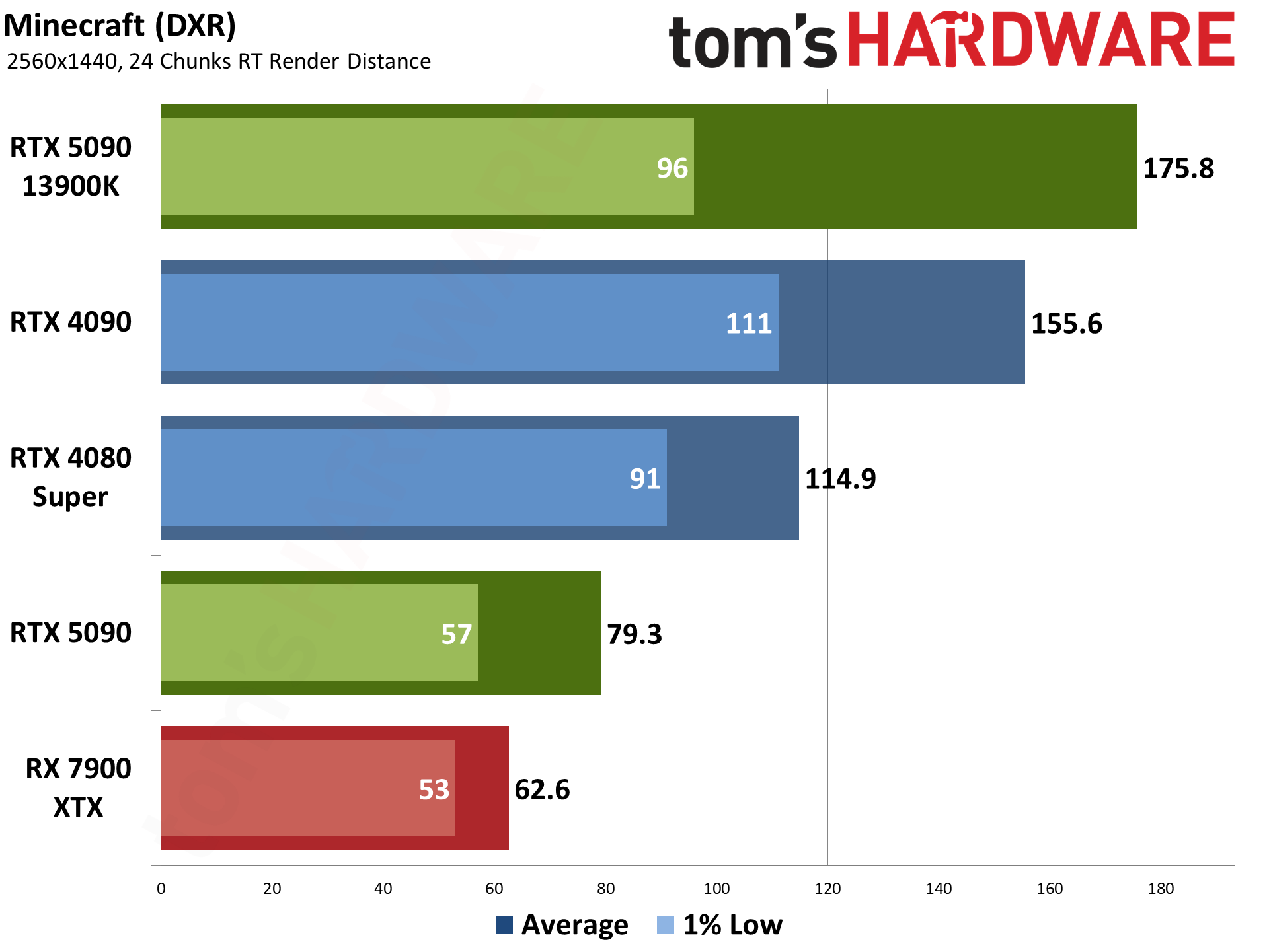
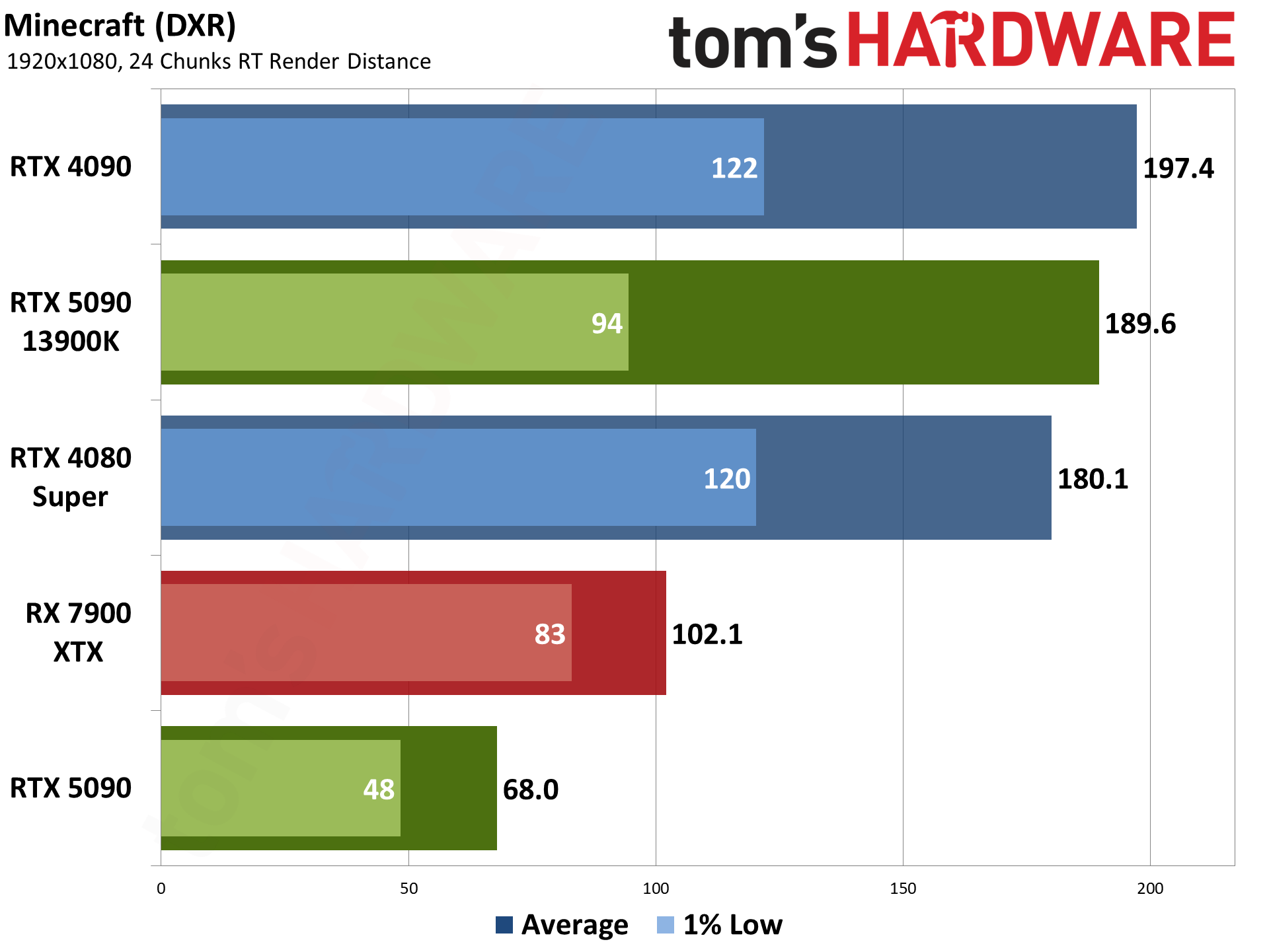

Minecraft supports full path tracing, as well as DLSS 2 upscaling on RTX cards. We don't enable DLSS, and the 5090 actually doesn't allow us to do that — a game or driver bug of some form.
The 5090 really underperformed in this game when running on the 9800X3D, but did better on the 13900K; Nvidia is looking into the situation. At best, the 5090 ties the 4090 right now with the 9800X3D, while the 13900K ends up delivering up to 20% higher performance than the 4090.
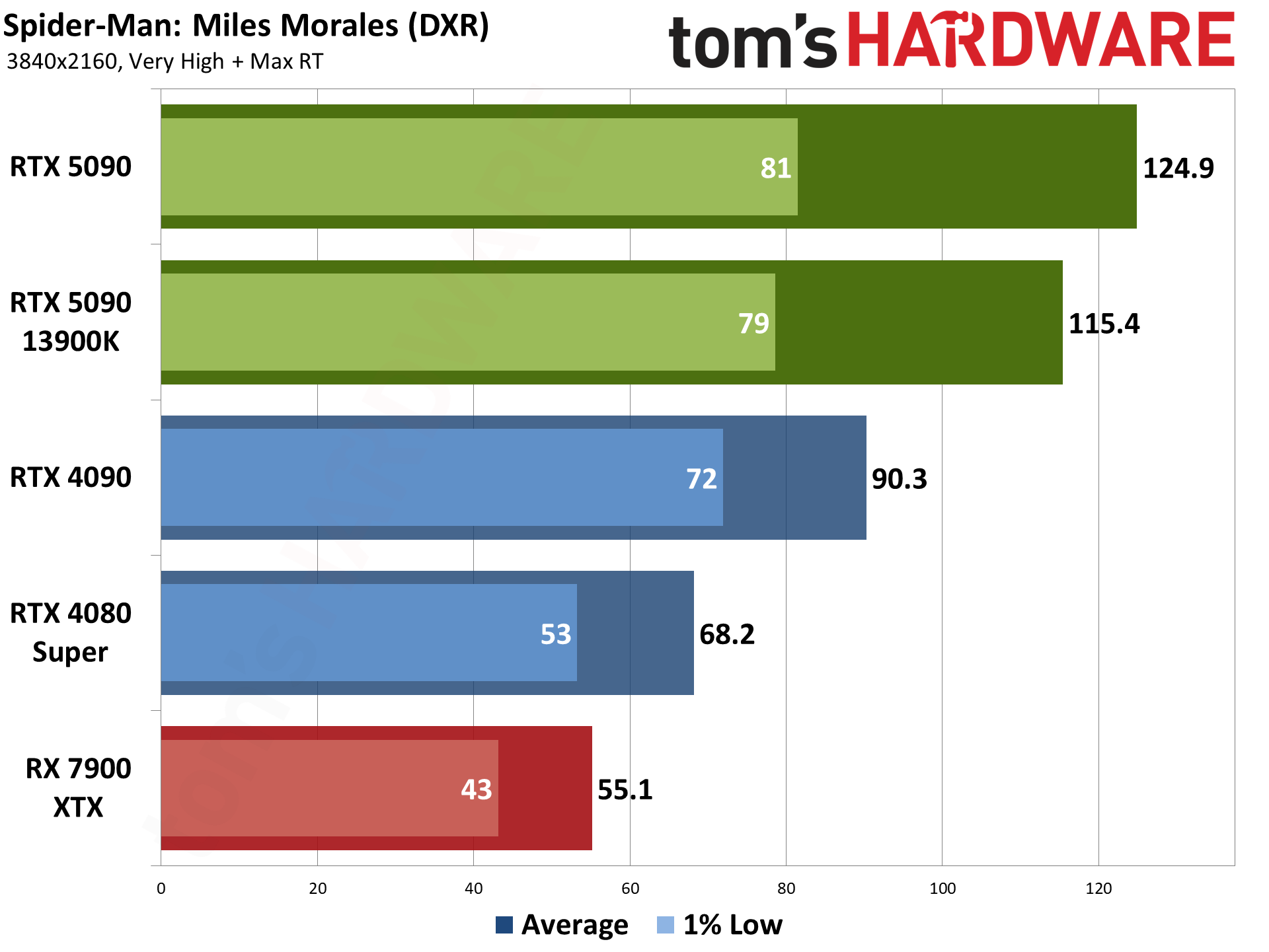
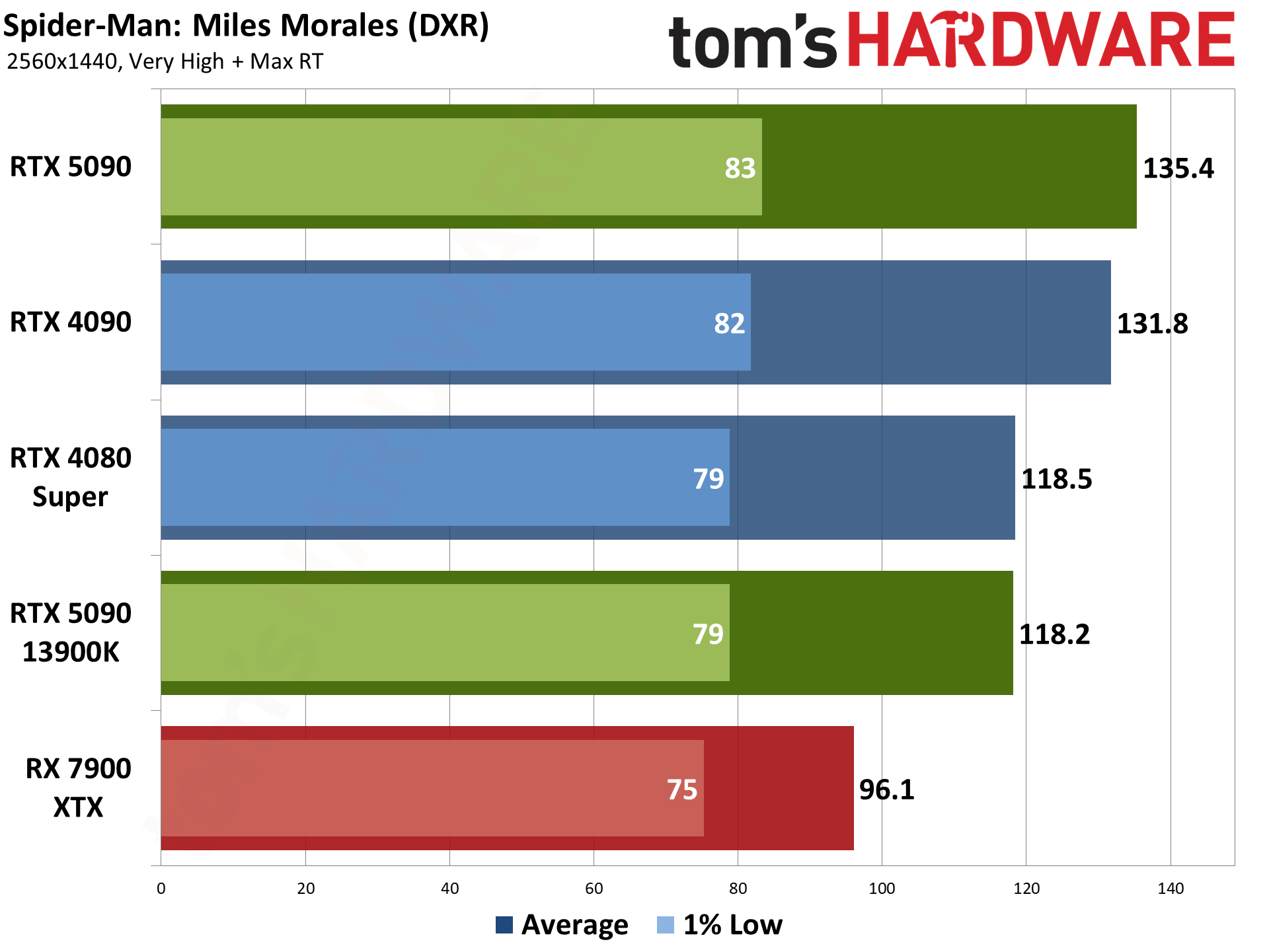
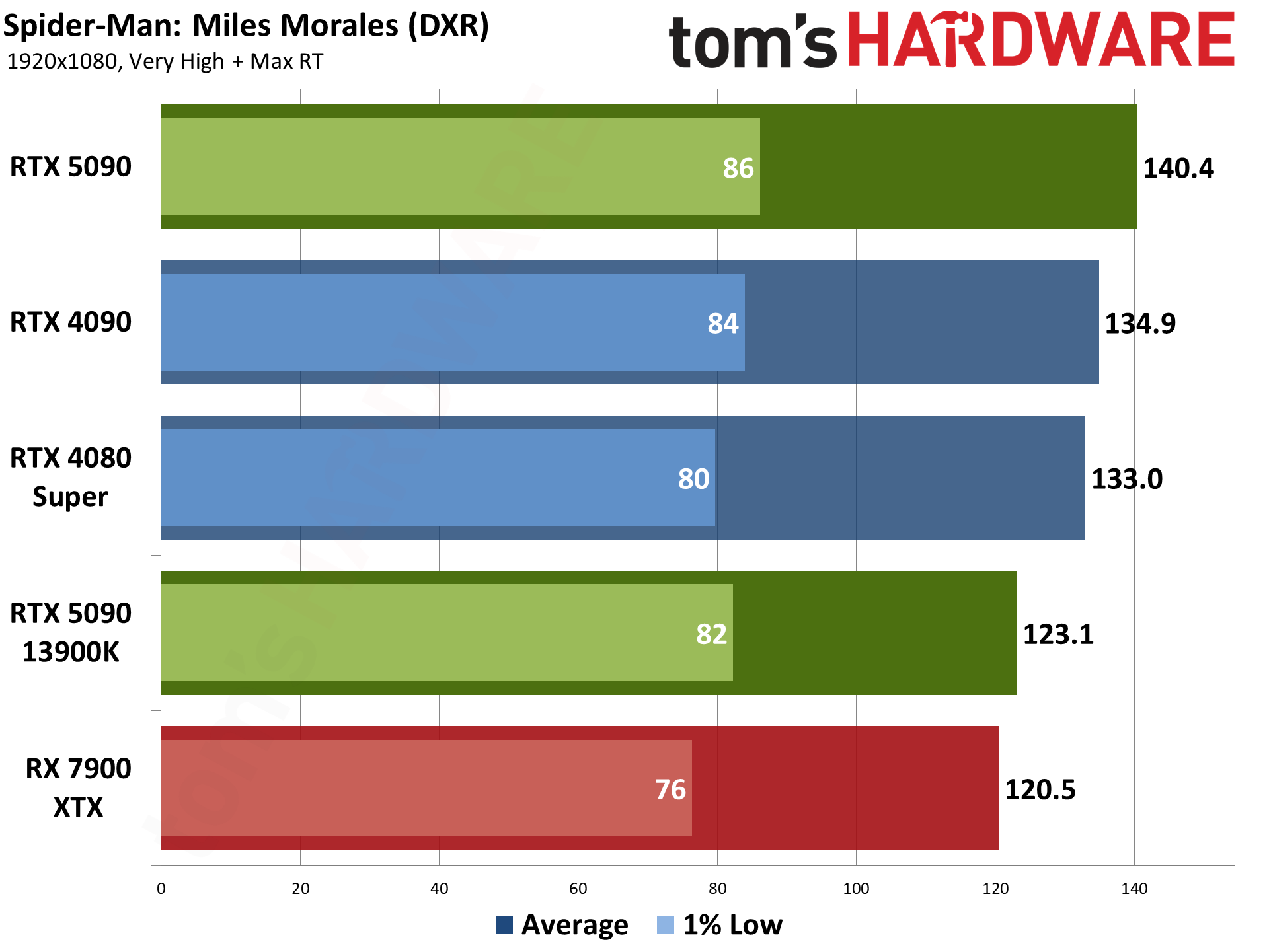
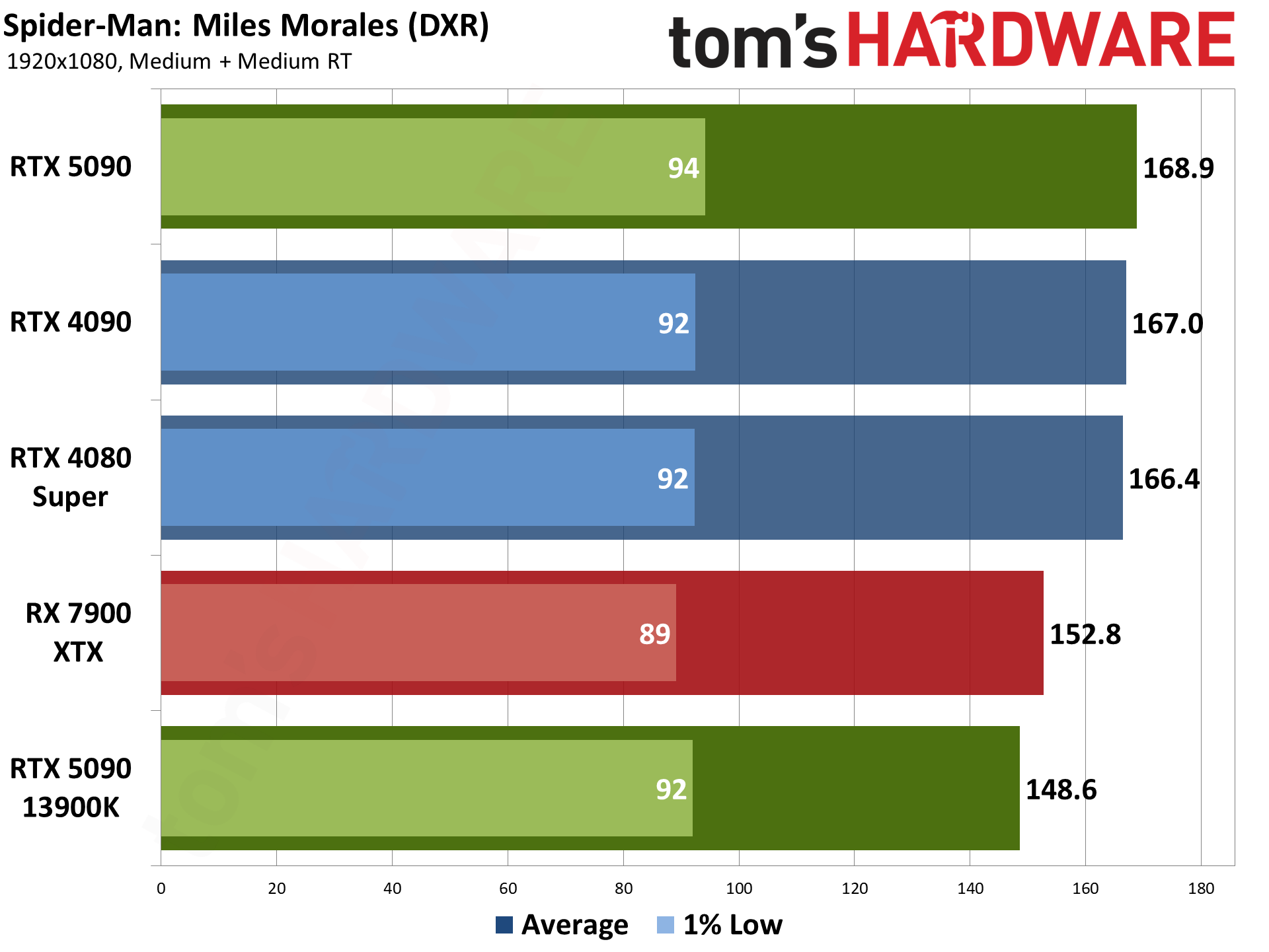
Last on our list of RT-enabled games, Spider-Man: Miles Morales doesn't look as nice with RT turned on as the previous Spider-Man: Remastered. The reflections are less obvious, and perhaps performance is better as a result. But beyond the RT effects, maxed out settings in Miles Morales definitely needs more than 8GB of VRAM. The 5090 shrugs nonchalantly as it flexes it's 32GB of memory.
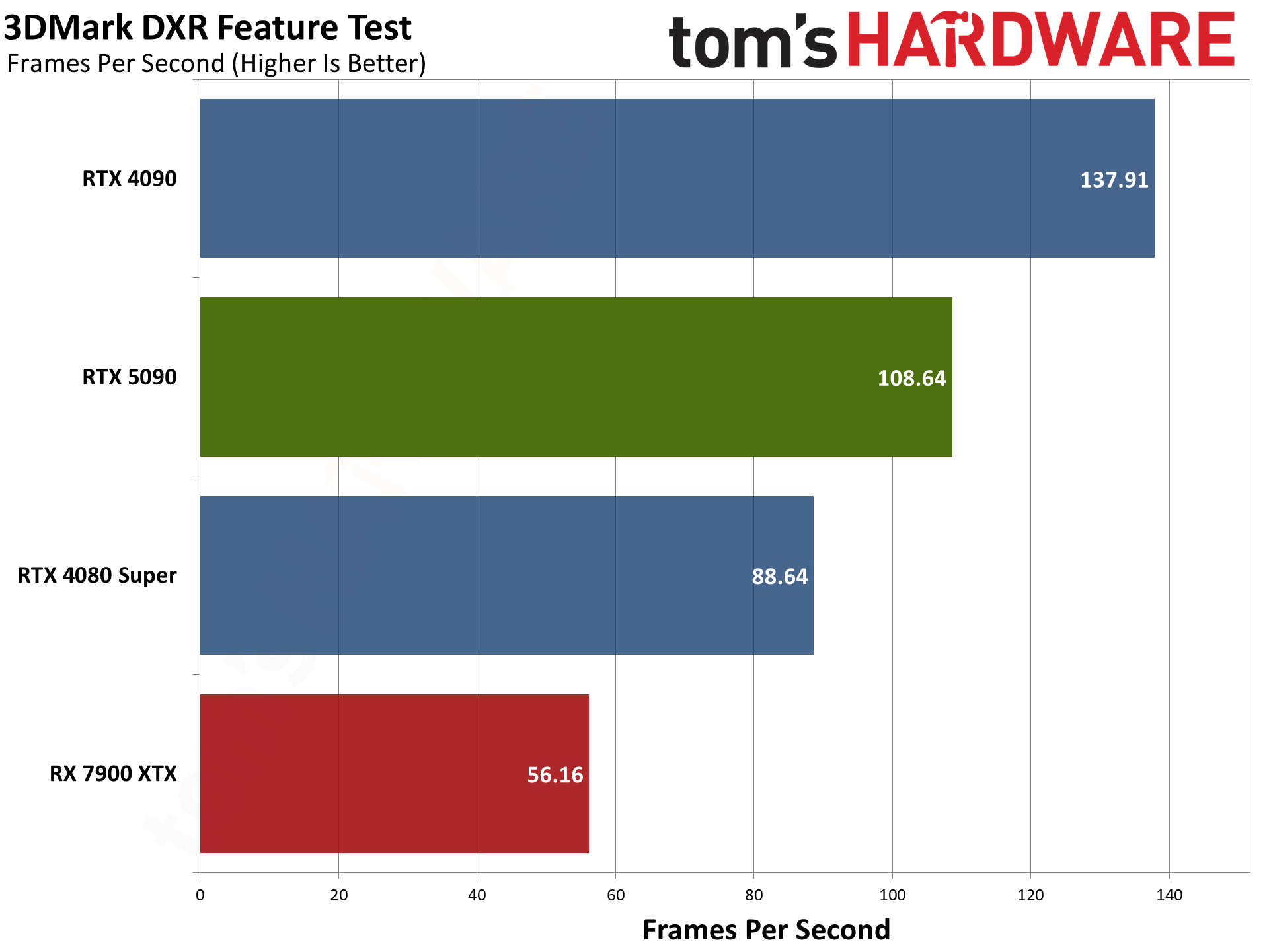
One final ray tracing benchmark we have is the 3DMark DXR Feature Test, where we report the average FPS rather than the calculated score. This is similar to full RT in a game, only done via a standalone benchmark and perhaps in a more vendor agnostic fashion. The RTX 5090 worked in this test, but it was slower than the 4090. Clearly, either some driver tuning or an application update are in order.
- MORE: Best Graphics Cards
- MORE: GPU Benchmarks and Hierarchy
- MORE: All Graphics Content
Current page: Nvidia RTX 5090 Ray Tracing Gaming Performance
Prev Page Nvidia RTX 5090 Rasterization Gaming Performance Next Page Nvidia RTX 5090 Full RT and DLSS 4 Testing
Jarred Walton is a senior editor at Tom's Hardware focusing on everything GPU. He has been working as a tech journalist since 2004, writing for AnandTech, Maximum PC, and PC Gamer. From the first S3 Virge '3D decelerators' to today's GPUs, Jarred keeps up with all the latest graphics trends and is the one to ask about game performance.
-
Crazyy8 Quick look, raster performance seems a bit underwhelming. Weird that the RTX 5090 can be slower than the 4090(in niche cases). Wasn't going to buy the 5090 anyway, too expensive for a plebe like me. Looking forward to DLSS 4 and how amazing(or not)it'll be.Reply -
Gururu Amazing but expected as far as I am concerned. I don't think there is a lot of need to compare against anything including AMDs new cards. It was brilliant to pair with the 13900 with crazy interesting results. Will read a few more times to glean more details. (y)Reply -
ReplyAdmin said:We also tested the RTX 5090 on our old 13900K test bed, with some at times interesting results. Some games still seem to run faster on Raptor Lake, though overall the 9800X3D delivers higher performance. The margins are of course quite small at 4K ultra.
For me, as a 13900K owner, that's a consolation :cool: -
Gaidax Okay, that IS a sick cooler that actually manages to do the job.Reply
I bet aftermarket 4 slot monstrocities will do better, but for 2 slots 600w that's insane. -
m3city Products like this should receive 3stars max. Great performance but at what cost? Is it the right direction that power draw increases at each iteration? Is it worth to chase max perf each time? For me it would be perfect if 5000 series stayed at same TDP as previous ones - meaning better design, better gpu - with understandably lower increase of perf compared to 4000. And then, 6000 series to have even reversed direction: higher perf with drop of TDP.Reply
And secondary, how come 500W gpu can be air cooled, but nerds on forums will claim you absolutely NEED water cooling for 125W ryzen, cause "highend"?. Yeah, i know 125W means more actual draw. -
redgarl Okay Jarred... you are shilling at this point.Reply
4.5 / 5 for a 2000$ GPU that barely get 27% more performances?
While consuming 100W more than a 4090?
And offering the same cost per frame value as a 4090 from 2 years ago?
Flagship or not, this is horrible.
Not to mention the worst uplift from an Nvidia GPU ever achieved... 27%...
https://i.ibb.co/4fks6Gt/reality.jpg -
redgarl Did you bench into an open bench or a PC case? I am asking because there is some major concerns of overheating because the CPU coolers is choked by the 575W of heat dissipation inside a closed PC Case. If you have an HSF for your CPU, then you are screwed.Reply
https://uploads.disquscdn.com/images/7a5bf4d586b20ffe0aa6281c57d419012a32cbdabd43b3e8050d2aa9a00d6cc1.png -
oofdragon 20% better at 4K and 15% better at 2K, all that having 30% more cores and etc............... got it. Oh boy the 5080 and 5070 are sure going to disappoint a lot of people.Reply
The good news is the RX 9070 will bring 4070 Ti Super performance to the table around $500 including the VRAM, ray tracing and dlss image quality. AMD will prolly counter the multi frame gen nonsense with something like the LSFG 3.0 is doing and smart buyers will finally have a good GPU to replace their 3080 or 6700 XT. -
vanadiel007 They should have given it code name sasquatch, because that's the chance you will be seeing these sell for $2,000 in the coming months.Reply
More like $3,000 and a lot of luck needed to find one in stock.
I pass on it. -
YSCCC a real space heater inside the case, and extremely expensive with not great raw performance increase... sounds like built for those with more money than brain or logic..Reply
